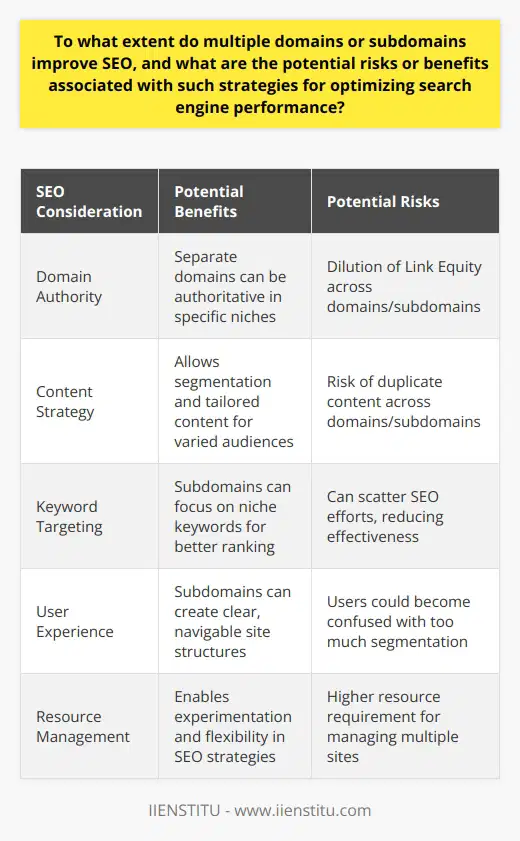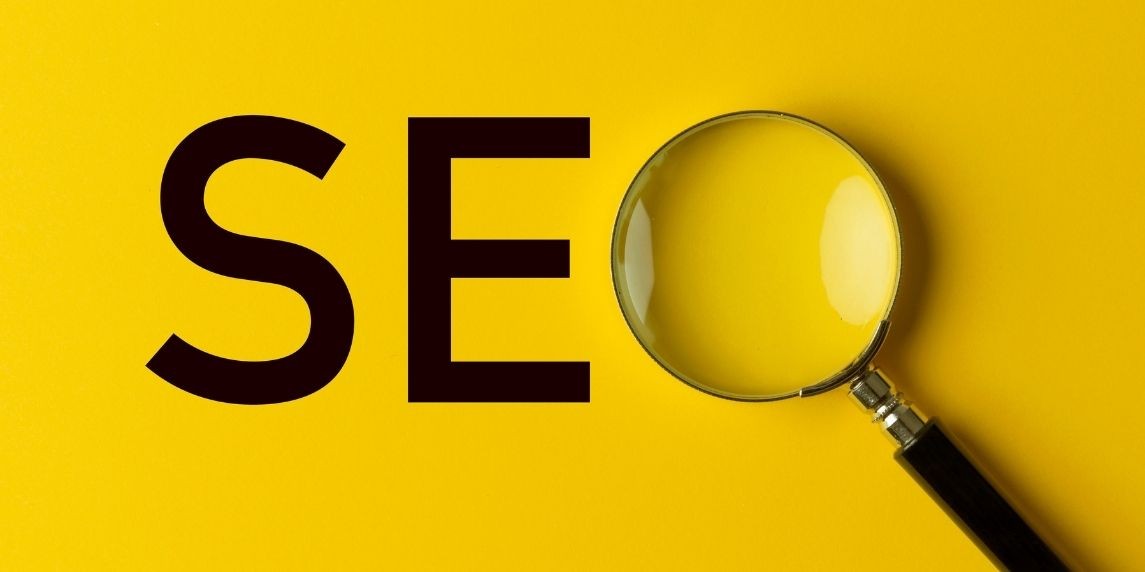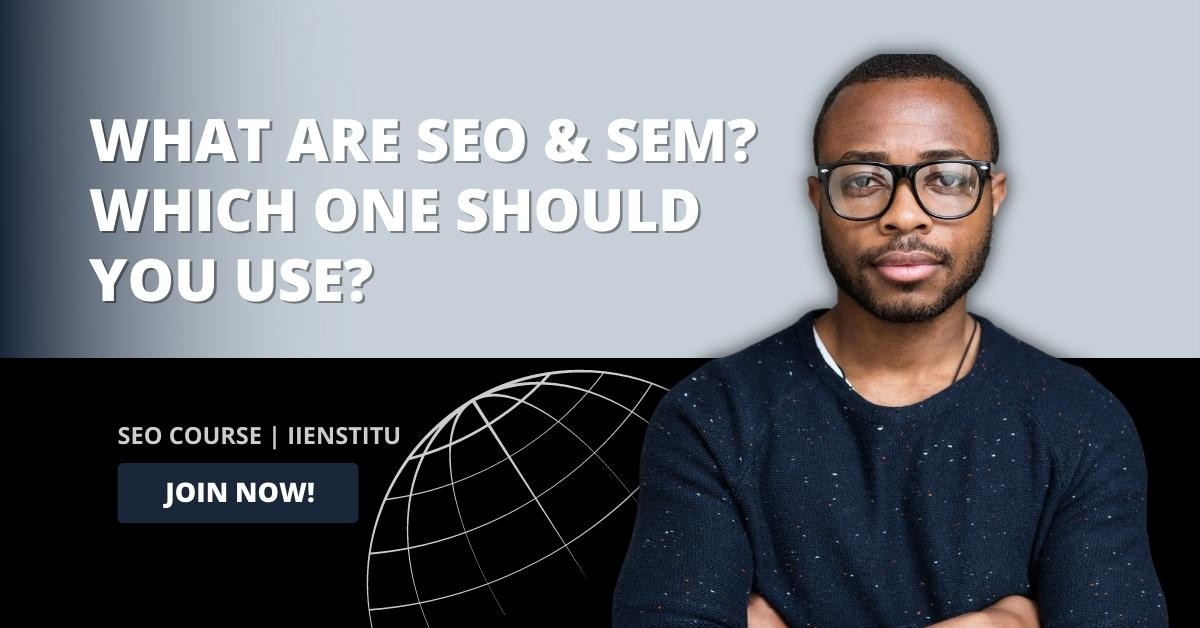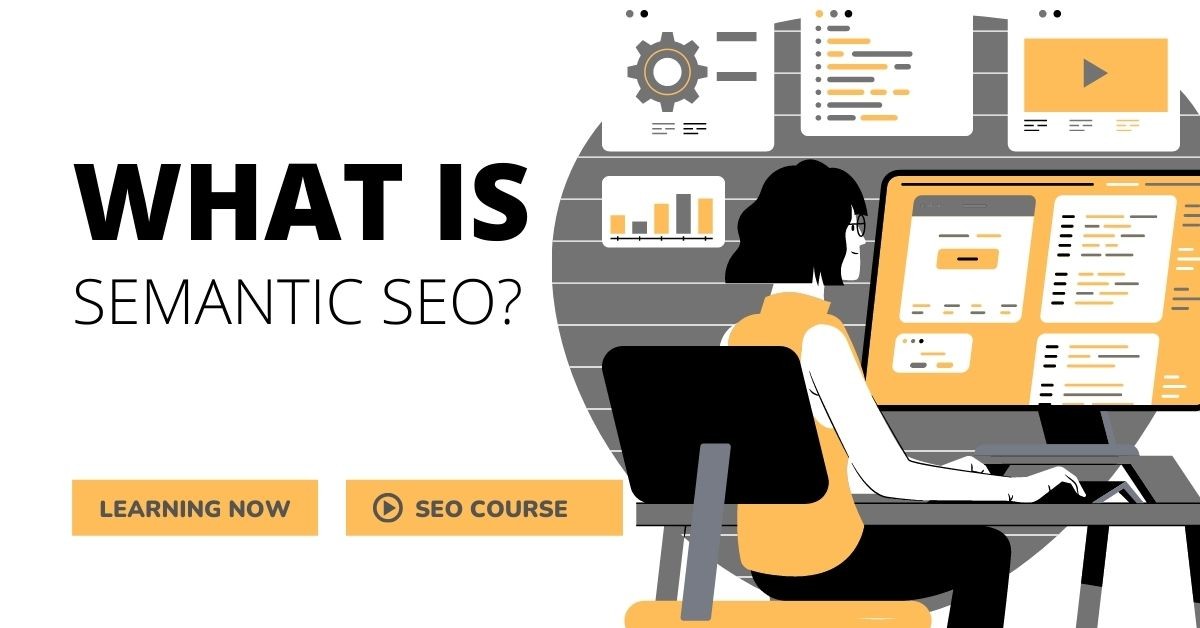
This article discusses the advantages of having multiple domains for SEO projects and the considerations that need to be considered when managing them. It emphasizes the importance of checking the domain health of both Google Search Console and Bing Webmaster Tools and assessing the potential implications of redirects and the impact on user experience. Additionally, it emphasizes the importance of linking between domains intelligently and appropriately to optimize existing strategies, content, and processes.
Introduction
Domain Health Considerations
Redirect Opportunities
Linking Between Domains
Conclusion
Introduction: Having multiple domains can provide several advantages for SEO projects. However, several considerations must be considered when managing multiple domains. This article will discuss domain health considerations, redirect opportunities, and links between domains.
Domain Health Considerations
Before performing any 301 redirects, it is essential to check the domain health of both Google Search Console and Bing Webmaster Tools. This is necessary to ensure that the domain in question does not have any penalties before associating it with the main domain. If any issues are found, they should be addressed before proceeding.
Redirect Opportunities
One of the main advantages of having multiple domains is the ability to redirect some of them back to the primary domain or a subfolder on the site. This can provide additional benefits for SEO projects. However, it is crucial to consider the implications of the redirects before proceeding. It is also essential to consider the potential impact on user experience.
Linking Between Domains
If the domains are being maintained as separate sites, it is essential to link them intelligently and appropriately. This can help to optimize existing strategies, content, and processes. However, it is also necessary to consider the potential impact on user experience when linking between domains.
Conclusion: Having multiple domains can provide several advantages for SEO projects. However, several considerations must be considered when managing multiple domains. This article has discussed domain health considerations, redirect opportunities, and links between domains. Before proceeding, it is essential to consider the potential implications of the redirects and the potential impact on user experience. Additionally, it is necessary to link between domains intelligently and appropriately to optimize existing strategies, content, and processes.
A well-optimized domain name and subdomain can be the key to unlocking a successful SEO campaign.
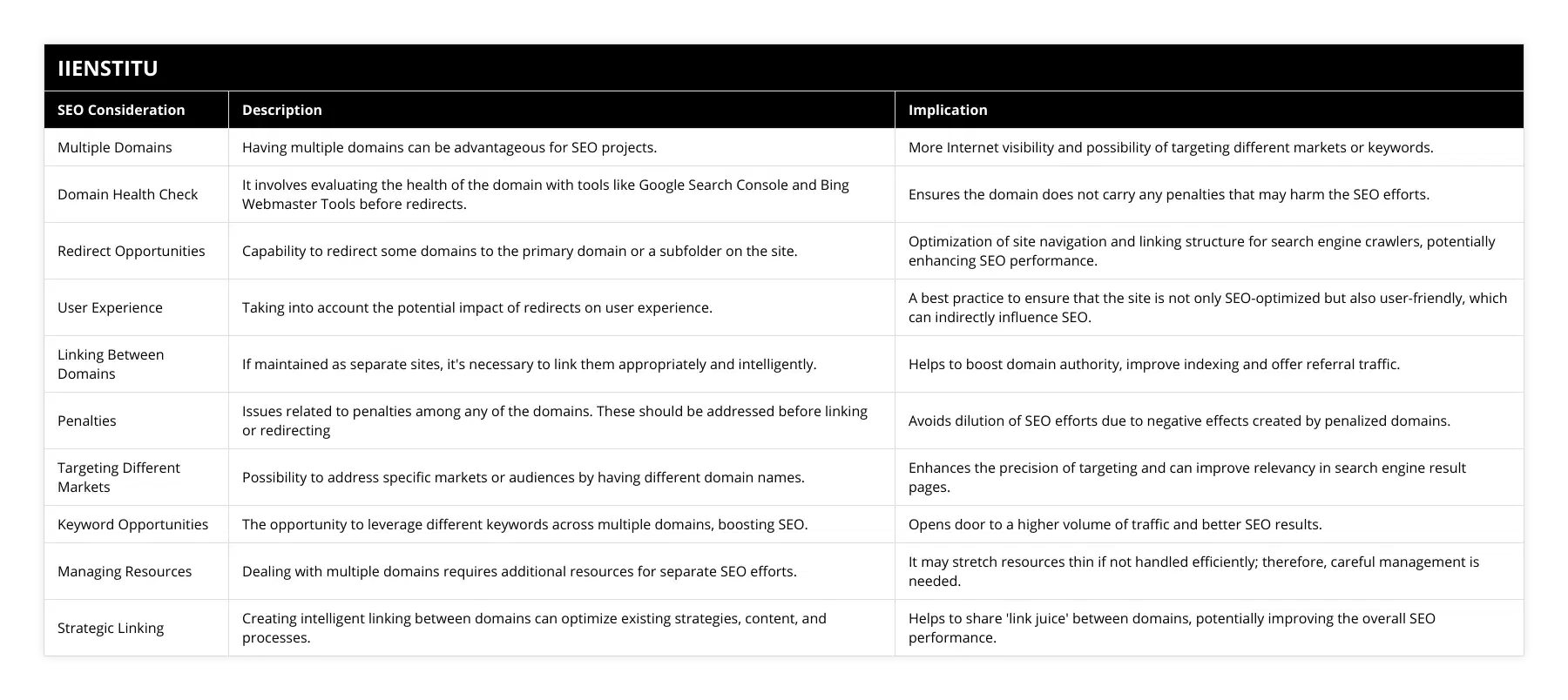
Frequently Asked Questions
What are the key considerations for optimizing domain names and subdomains for SEO?
When it comes to optimizing domain names and subdomains for SEO, several critical considerations need to be considered. This blog post will explore these considerations and guide how to ensure maximum SEO performance when configuring domain and subdomain settings.
The first key consideration is the choice of the domain name. Choosing a domain name that accurately reflects the website’s content is essential, making it easier for search engines to understand and index the website. Additionally, the domain name should be easy to remember and type, as this will help users find the website more easily.
The second key consideration is the choice of top-level domain (TLD). Different TLDs may be more or less suitable depending on the website's purpose. For example, if the website is intended for a global audience, a .com TLD may be preferable. In contrast, if the website is designed for a local audience, a country-specific TLD may be more appropriate.
The third key consideration is the use of subdomains. Subdomains can be used to separate different sections of a website, such as a blog or a store, and can also be used to host different versions of the same website (e.g., a French version of the website). However, it is essential to know that search engines may treat subdomains as separate websites. Therefore, it is necessary to ensure that the content on each subdomain is unique and not duplicated from other parts of the website.
Finally, it is essential to ensure that all URLs are correctly formatted and use consistent redirects. This will help to ensure that users are directed to the correct page and that search engines can properly index the website.
In conclusion, several critical considerations exist for optimizing domain names and subdomains for SEO. Websites can achieve maximum SEO performance by considering these considerations and ensuring that all URLs are correctly formatted and using consistent redirects.

How can redirect opportunities be used to improve SEO performance?
Redirect opportunities are an essential tool for improving SEO performance. Search engine optimization (SEO) is a strategy used to increase the visibility of a website or web page in search engine results. To increase their visibility, website owners must ensure that their websites are correctly optimized for search engine crawlers. Redirects are an effective way to improve SEO performance because they enable website owners to point search engine crawlers to the most relevant content, ensuring that the content is presented in the most optimized way and giving it the best chance of being indexed.
Redirectors allow website owners to optimize their websites for specific keywords, phrases, or topics. By redirecting traffic to the most relevant content, website owners can ensure that the content is correctly represented in the search engine index. This results in improved SEO performance and higher rankings in search engine results. Additionally, redirects can improve the user experience and ensure visitors are not presented with outdated or irrelevant content.
Redirects can also be used to improve the performance of specific pages on a website. For example, a website owner might redirect search engine crawlers to the desired page, ensuring that the page is indexed quickly and accurately. This can improve the page's visibility and ensure it is correctly represented in search engine results. Additionally, redirects can point visitors to the most relevant content. For example, if a visitor is looking for a product or service, the website owner can redirect the visitor to the most relevant page.
Finally, redirects can be used to improve the performance of websites in international markets. By using redirects, website owners can ensure that their websites are correctly optimized for different countries and languages. This can help improve the website's visibility in international search engine results and ensure that the website is accurately represented in the most relevant markets.
In conclusion, redirects can be a powerful tool for improving SEO performance. By using redirects to point search engine crawlers and visitors to the most relevant content, website owners can ensure that their websites are correctly indexed and represented in search engine results. Additionally, redirects can be used to improve the performance of specific pages on a website and ensure that websites are appropriately optimized for international markets.
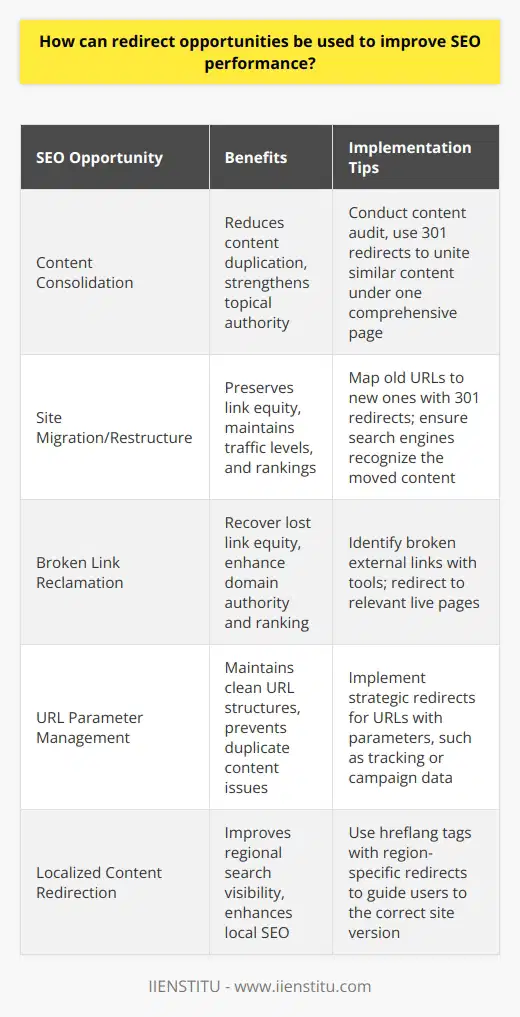
What are the best practices for linking between domains to maximize SEO benefits?
Search engine optimization (SEO) is an integral part of website optimization, and linking between domains is one of the most effective ways of maximizing SEO benefits. Linking between domains can improve your website’s visibility in search engine rankings, drive more traffic, and ultimately increase your website’s profitability. In this blog post, we will discuss the best practices for linking between domains to maximize SEO benefits.
First and foremost, ensuring that all your website’s internal links are set up correctly is essential. This is especially true for websites that are spread across multiple domains. All internal links should be set up to point to the relevant domain for each page. This will help ensure that search engine spiders can crawl and index your website more effectively. You should also ensure that all your internal links use the correct anchor text. This is important as search engines use anchor text to determine the relevance of a page to a particular keyword or phrase.
Another essential practice for linking between domains is ensuring that you use the correct outbound links. Outbound links point to other websites and can be used to improve your website’s visibility in search engine rankings. When using outbound links, it is essential to ensure they are relevant to your website’s content and the query users are searching for. You should also make sure you are only linking to websites with a good reputation. This means avoiding sites with a history of spamming or other malicious activities.
Finally, it is essential to ensure that your website is well-structured. This means that all your website’s pages should be interconnected logically. This will help search engine spiders crawl and index your website more effectively, which in turn will help improve your website’s visibility in search engine rankings. Additionally, a well-structured website can make it easier for users to navigate your website, which can help drive more traffic to your website.
In conclusion, linking between domains can effectively increase your website’s visibility in search engine rankings and drive more traffic to your website. To maximize the SEO benefits of linking between domains, it is essential to ensure that all your website’s internal links are set up correctly, that you are using relevant outbound links, and that your website is well-structured. Following these best practices can help ensure that your website is optimized for search engine visibility and can help to increase your website’s profitability.

Do domain names affect SEO, and if so, in what way?
Impact of Domain Names on SEO
Domain names play a crucial role in search engine optimization (SEO) as they convey valuable information about a website's purpose and content. Incorporating relevant keywords within a web domain is a helpful strategy for enhancing its visibility on search engines.
Keywords in Domain Names
Incorporating keywords in domain names may positively influence search engine rankings. Search engines use domain names to determine the site's relevance to user queries, allowing websites with keyword-rich domains to rank higher for those specific terms. Consequently, domain names with targeted keywords enable better keyword targeting and alignment with user search intent.
Domain Name Extensions
A website's domain extension, or top-level domain (TLD), also has potential implications for SEO. Generic extensions, such as .com and .org, are internationally recognizable and may facilitate higher search rankings regardless of a search engine user's location. However, geotargeted domain extensions (.co.uk, .ca, etc.) can be advantageous for businesses targeting specific regions, as search engines may prioritize these domains for users in those areas.
Brandability and Memorability
A domain name that is branded and memorable can indirectly influence SEO rankings. Users are more likely to remember, share, and link to easily recognizable and pronounceable domain names. These factors can positively impact search engine ranking factors, such as click-through rate, dwell time, and the number of backlinks to a website.
Domain Age
While not a significant ranking factor, domain age can add value to a website's SEO performance. Older domains may be perceived as having more credibility and authority within search algorithms. Additionally, a website with a longer online presence has likely accumulated more backlinks, social shares, and user-generated content, which can impact its SEO favorably.
Domain History
A domain's history has the potential to affect SEO performance. Previous associations with spammy practices, excessive backlinks, or flagged content can prompt search engines to view the domain as untrustworthy, resulting in lower search rankings. Therefore, when acquiring an existing domain, examining its past activities and interactions is essential to ensure it will not negatively impact a new site's SEO.
In conclusion, domain names undeniably affect SEO in various ways, from keyword relevance to brandability and memorability. By considering the elements of a highly effective domain name and implementing relevant strategies, website owners can enhance their search engine visibility and ranking potential.
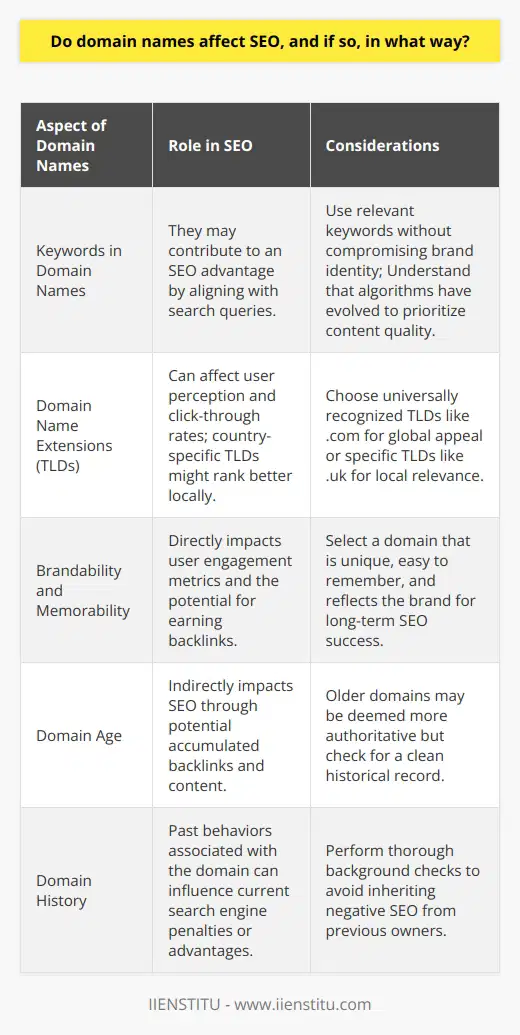
How can one determine the best type of domain for optimizing SEO performance?
Assessing Domain Types for SEO
**Consider Keywords**
One approach to determining the optimal domain for enhancing SEO performance is to prioritize search-relevant keywords. By incorporating highly searched terms and phrases within the domain, the likelihood of greater search engine visibility increases. This strategy aids in higher ranking on search engine results pages, attracting more traffic to the blog post.
**Select a Top-Level Domain**
The choice of a top-level domain (TLD) significantly influences SEO performance. Research indicates that search engines, especially Google, give preference to generic TLDs such as .com, .org, and .net. Selecting from these TLDs helps in creating an authoritative and trustworthy online presence, positively impacting the SEO performance of a blog post.
**Focus on Branding**
Another key factor when selecting a domain is to emphasize strong branding. A unique and memorable domain name, which effectively communicates the blog's purpose or content theme, also positively influences SEO performance. Establishing a strong brand identity enables search engines to better recognize and rank the blog post, which leads to improved visibility.
**Target a Specific Geo-Location**
In cases where the blog post targets a specific geographical audience, it is advisable to choose a country-code TLD (ccTLD). Opting for ccTLDs allows search engines to easily identify the target geo-location and rank the blog post accordingly. Consequently, the blog post will receive higher search result rankings within the intended audience, optimizing SEO performance.
**Prioritize Domain Authority**
Lastly, domain authority directly impacts SEO performance. A domain with a high domain authority score, reflecting its trustworthiness and credibility in the online community, tends to achieve higher search result rankings. Monitoring metrics such as domain age, relevant backlinks, and quality content can assist in building domain authority.
In conclusion, determining the best type of domain for optimizing SEO performance involves considering various factors - including keywords, TLDs, branding, geo-targeting, and domain authority. By focusing on these elements, blog owners can significantly improve their search engine rankings and overall online visibility.
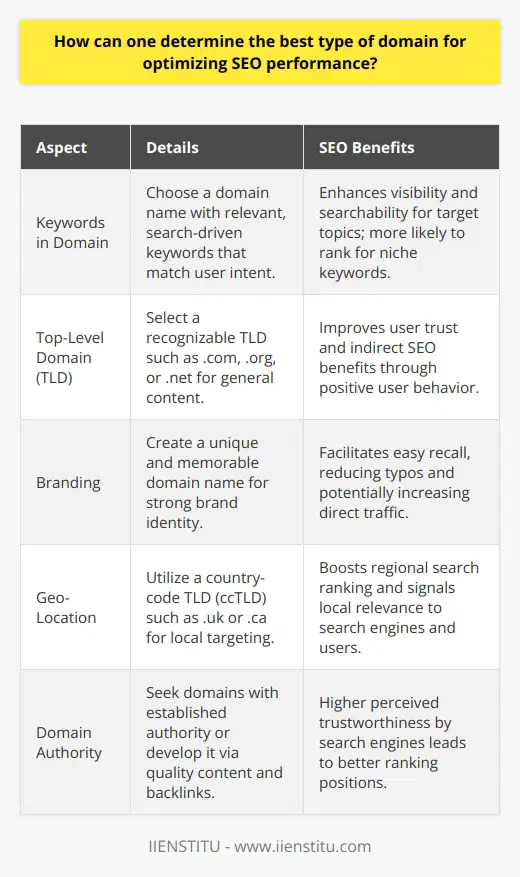
Are there specific factors to consider when utilizing subdomains to ensure the main domain's SEO is not negatively affected?
Subdomain Considerations for SEO
When utilizing subdomains for a blog, it is essential to consider several factors to ensure that the main domain's SEO is not adversely affected. The following are some of these factors:
Content Relevance
Make sure that the content on the subdomain is relevant to the main domain. This will assist the search engine in understanding the relationship between the main domain and the subdomain, resulting in a better ranking for both.
Internal Linking
It is crucial to maintain proper internal linking between the main domain and the subdomain. Ensure that the links are natural, contextual, and follow a proper keyword strategy. This helps in enhancing the main domain's SEO and strengthens the subdomain's performance in search results.
Canonical Tags
Utilize canonical tags on the subdomain pages to indicate the preferred page version to search engines. This prevents duplicate content issues, consolidates link equity, and protects the main domain's ranking potential.
Subdomain Indexing
Ensure that the search engine is indexing your subdomain by submitting a separate XML sitemap for the subdomain. This helps search engines to understand the subdomain's content and the interrelationship between the main domain and the subdomain.
Targeting Different Regions
If the subdomain targets a different region or language than the main domain, using separate hreflang tags for the main domain and the subdomain will allow search engines to display the most relevant version of the website to the user.
Mobile-First Design
Make sure the subdomain is mobile-friendly, as most search engines prioritize mobile-first indexing. Optimize the subdomain's loading speed, responsive design, and user experience to provide a seamless browsing experience for mobile users.
Monitor Subdomain Performance
Regularly monitor the subdomain's performance using various SEO tools and analytics platforms. Assess its impact on the main domain's SEO and make necessary adjustments to improve overall website performance.
In conclusion, taking the time to carefully consider and implement these factors when utilizing subdomains can significantly impact your main domain's SEO ranking positively. Ensuring content relevance, proper internal linking, and technical optimizations can help your subdomain contribute to your main domain's overall SEO success.
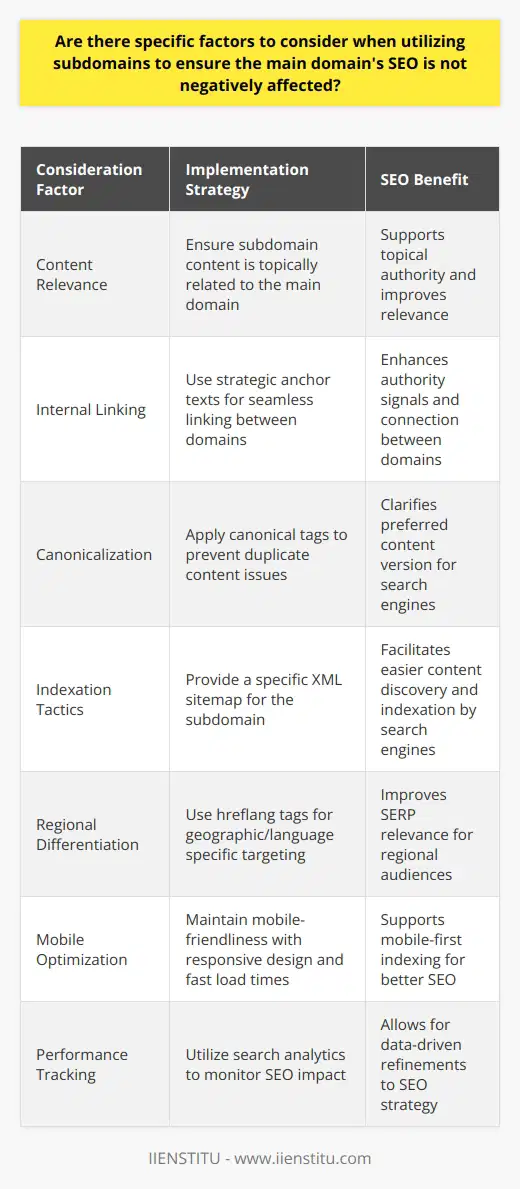
Do the choice of domain names and their structure have a notable impact on a website's SEO ranking?
Impact of Domain Names on SEO Ranking
Domain Name Relevance
The choice of domain names and their structure indeed have a notable impact on a website's Search Engine Optimization (SEO) ranking. A domain name with relevant keywords can assist search engines in identifying the website's purpose and theme, consequently improving its ranking in search results. For example, a website about digital marketing will benefit from having a domain name that includes relevant terms, such as 'digitalmarketingtips.com.'
Ease of Branding and Memorability
In addition to keyword relevance, a memorable and easily recognizable domain name further aids in improving a website's SEO ranking. A short, unique, and easily pronounceable domain name makes it more likely for users to remember and share the website with others. Increased website traffic and social signals contribute to the website's overall search ranking.
Hyphen Usage and TLD Selection
Hyphenated domain names should be used sparingly, as excessive hyphens can appear spammy and decrease a site's credibility, negatively impacting its SEO ranking due to decreased user interaction. Furthermore, selecting an appropriate Top-Level Domain (TLD) can help increase a site's visibility. Indicative TLDs, such as '.com', are considered prime real estate and have been proven to perform better in search results.
Domain Age and History
Domain age and history also contribute to SEO ranking. Older, well-established domains with a clean history and no penalties have a higher trust factor with search engines, leading to better rankings. However, it should be noted that the overall website content quality and compliance with search engine guidelines are crucial factors in determining SEO ranking, not just the domain name and structure alone.
In conclusion, the choice of domain names and their structure play a significant role in determining a website's SEO ranking. By focusing on keyword relevance, memorability, appropriate hyphen usage, and TLD selection, website owners can improve their SEO performance. Additionally, older domains with clean histories can offer potential advantages in search rankings, but ensuring high content quality and adhering to search engine guidelines remain integral to achieving long-term SEO success.
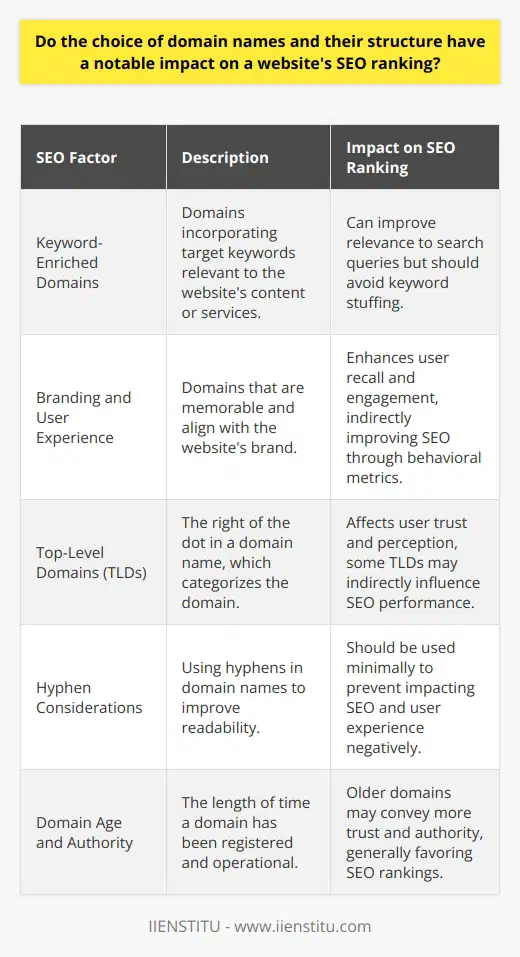
To what extent can having multiple domains, either for regional targeting or other purposes, be advantageous or detrimental for a website's overall SEO success?
Regional Targeting Advantages
Having multiple domains for regional targeting can be advantageous for a website's overall SEO success. This approach allows businesses to cater to specific markets and tailor their content to suit the preferences, languages, and cultures of different regions. As a result, users are offered a more personalized experience which leads to increased engagement and improved search rankings. Moreover, local search engines may prioritize region-specific domains, leading to higher visibility and web traffic.
Language and Cultural Benefits
Another benefit of using multiple domains is the ability to showcase multilingual and culturally diverse content. This enables the website to cater to a broader audience and increase its global reach, resulting in higher overall web traffic. Furthermore, offering content in multiple languages has a positive impact on SEO, as search engines reward the provision of valuable and linguistically inclusive material.
Domain Authority
On the other hand, working with multiple domains has its downsides. One of the primary concerns pertains to domain authority, which is a crucial factor in determining search rankings. With multiple domains, businesses may struggle to establish and maintain a strong overall domain authority due to divided attention across the different websites. This may result in lower search rankings and, consequently, less organic traffic.
Duplicate Content Issues
Multiple domains could lead to duplicate content issues if businesses present similar or identical material across the different websites. Search engines, particularly Google, frown upon duplicate content and could potentially penalize the websites involved, negatively impacting their SEO performance. Therefore, having different domains demands extra effort in tailoring unique material for each site to avoid such issues.
Conclusion
In summary, using multiple domains for regional targeting or other purposes can yield significant advantages in terms of personalized content, regional preferences, and language inclusivity. However, these benefits must be weighed against the potential challenges posed by reduced domain authority and duplicate content issues. Ultimately, the success of a website's SEO strategy with multiple domains hinges on the effective management and differentiation of the individual sites.
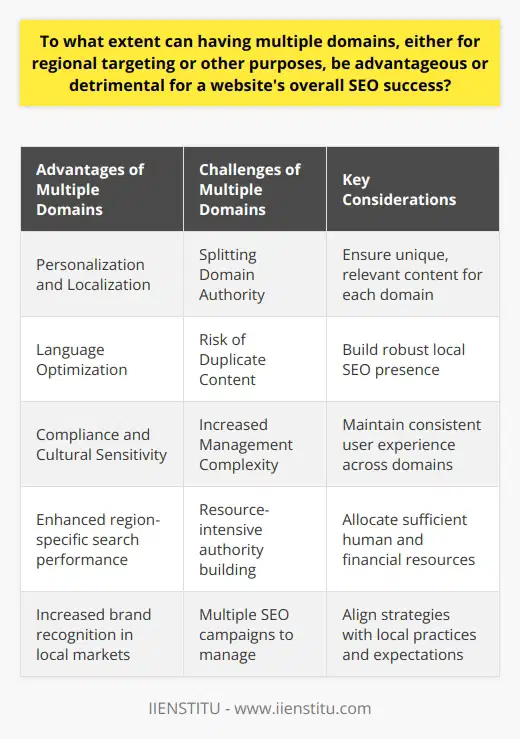
In the context of search engine optimization, how do different top-level domain extensions, such as .com, .org, or .io, affect a website's perceived authority and resulting SEO performance?
Impact of Top-Level Domain Extensions on SEO Performance
Domain Authority and Users' Perception
Different top-level domain (TLD) extensions, such as .com, .org, and .io, play a crucial role in determining a website's perceived authority. This perception influences users' trust and their likelihood to visit a site. For instance, websites with .com or .org extensions generally convey a sense of credibility, as they are traditionally associated with commercial or non-profit organizations, respectively. On the other hand, .io, an emerging domain popular among tech startups, may appeal more to a niche audience.
Search Engine Ranking Factors
While domain extensions influence user perception, their direct impact on search engine optimization (SEO) is less significant. Major search engines utilize numerous factors to rank websites, including relevance, backlinks, and quality content. Although the use of established TLDs, like .com or .org, might contribute to a site's credibility, it is not necessarily a determining factor in its overall SEO performance.
Geotargeting and ccTLDs
Country code top-level domains (ccTLDs), such as .uk, .de or .fr, can impact SEO performance due to their association with specific geographic regions. These extensions provide a clear signal to search engines that a website targets users in a particular country. As a result, websites with ccTLDs tend to perform better in local search results, enhancing their visibility and SEO performance in the targeted region.
Generic TLDs and Branding
In recent years, the introduction of new generic top-level domains (gTLDs), such as .shop, .app or .design, has allowed businesses and organizations greater flexibility in representing their brand and industry. While gTLDs can contribute to a unique brand identity, they have a limited impact on a site's SEO performance. Ultimately, a website's SEO success depends primarily on its content quality, relevance, and user engagement.
Conclusion
In the context of search engine optimization, a website's top-level domain extension has a limited direct effect on its SEO performance. Branding and user perception, however, are influenced by a website's domain choice. Moreover, ccTLDs may have geotargeting benefits for websites seeking to reach specific regional audiences. Overall, a website's content, user experience, and relevance remain the most important determinants of its SEO success.
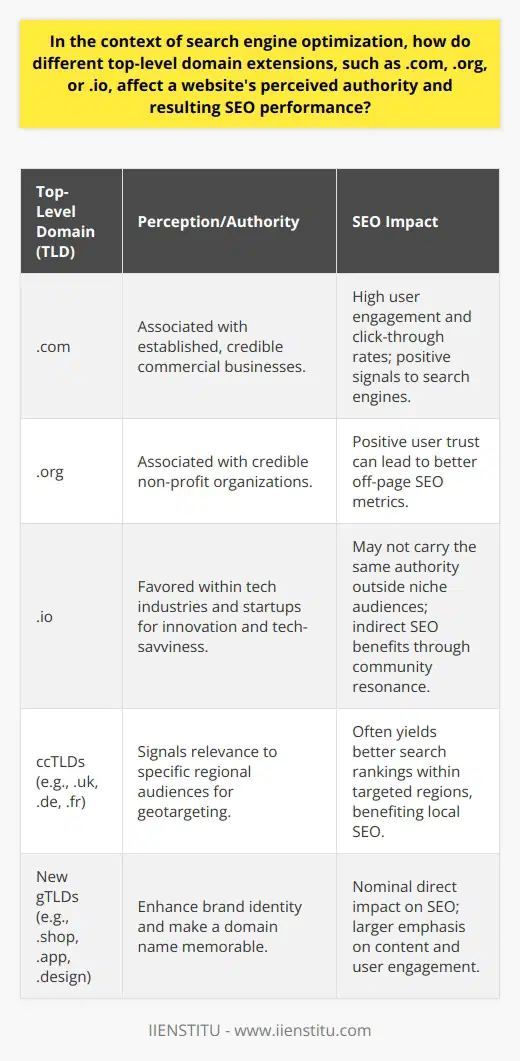
How do I optimize my domain name for SEO?
Domain Optimization for SEO
To optimize a domain name for SEO, one must carefully consider its structure and relevance to the content. Choosing a relevant, memorable, and unique domain name that reflects the subject matter of the blog post demonstrates its significance to search engines.
Keyword Selection in Domain Name
Incorporating target keywords within the domain name boosts SEO as it constructs a strong association between the domain and its content. Using relevant keywords enhances the chances of being identified by search engines, leading to higher rankings and improved organic traffic.
Brand Identity and Domain Extension
Establishing a strong, cohesive brand identity aligns with a domain name that accurately represents the blog's theme or niche, therefore improving SEO. A suitable domain extension (.com, .org, etc.) also plays an essential role in optimizing domain names; selecting the most widely used and recognizable extensions can result in better search rankings.
Readability and Length
Ensuring the domain name is easy to read and kept brief will enhance the user experience and encourage site visits. A concise, easily pronounceable domain name can improve the chances of being remembered, shared, and typed in search bars, thereby contributing to the optimization of the domain name for SEO.
Avoiding Hyphens and Numerals
It is advisable to avoid using hyphens and numerals in the domain name. These elements can create confusion and diminish the perception of the blog's credibility. A simple and easily understood domain name fosters trust and credibility, leading to increased user engagement.
Renewing Domain Registration
Lastly, renewing the domain registration for an extended period signals stability, trust, and investment in the future of the blog to search engines. This shows long-term commitment, which can contribute to enhancing the domain's reputation and establishing its legitimacy, thus optimizing it for SEO.
By following the mentioned strategies, a blog author can enhance the domain name's optimization for SEO, increasing its search engine ranking, visibility, and organic traffic. Ensuring a memorable and relevant domain name that accurately represents the blog's content establishes its legitimacy and ultimately results in a higher chance for success.
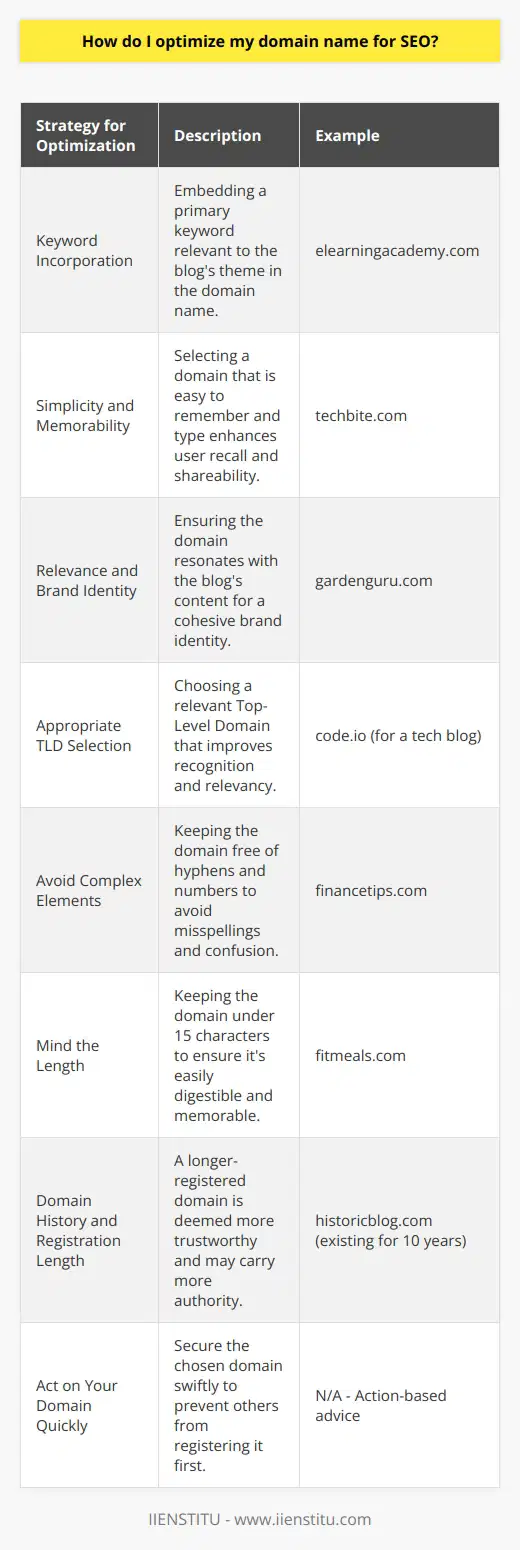
Do subdomains affect main domain SEO?
Impact of Subdomains on Main Domain SEO
Understanding Subdomains
Subdomains are extensions of the main domain, used to categorize and separate different sections of a website. They help organize content and improve user experience by making navigation easier. Examples of subdomains include blog.example.com, store.example.com, and forum.example.com.
Effects on SEO Performance
Contrary to popular belief, subdomains do not directly impact the main domain's search engine optimization (SEO) performance. Google and other search engines consider subdomains as separate entities from the main domain. However, subdomains can indirectly affect the main domain's SEO through various factors, such as the quality of content, backlinks, and user engagement.
Quality of Content
High-quality content on a subdomain can contribute positively to the main domain's SEO performance. When subdomains contain well-researched, engaging, and informative content, they can attract traffic and generate interest in the main domain.
Backlinks and Authority
The use of subdomains can improve the main domain's backlink profile if they attract high-quality backlinks. Backlinks from reputable websites indicate that the subdomain provides valuable content, and search engines use this information to determine the main domain's overall authority. This authority can, in turn, lead to better rankings for the main domain in search engine result pages (SERPs).
User Engagement
Subdomains can enhance user engagement by providing targeted and relevant content for different user groups. Increased user engagement can boost the main domain's reputation and credibility, leading search engines to assign higher rankings to the main domain in their SERPs.
Potential Drawbacks
Although subdomains can indirectly benefit the main domain's SEO, there are some potential drawbacks to consider. For example, splitting site content across multiple subdomains can dilute the main domain's authority and make it harder to rank for competitive keywords. Additionally, managing and optimizing multiple subdomains can be more complex and time-consuming compared to using a single domain structure.
In conclusion, subdomains do not directly affect the main domain's SEO, but they can have both positive and negative indirect impacts. When using subdomains, it's crucial to focus on quality content, reputable backlinks, and user engagement. It's essential to weigh the benefits against the potential drawbacks and determine which approach aligns with your overall SEO strategy.
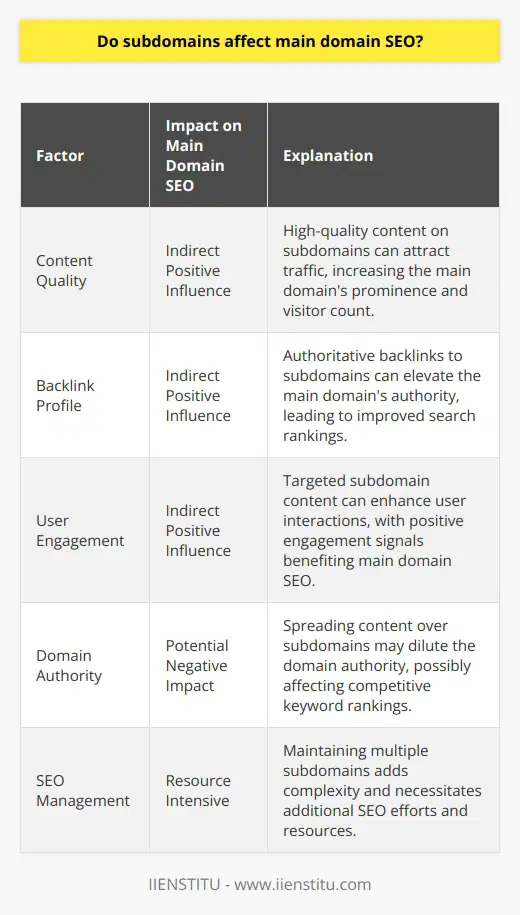
Are subdomains SEO friendly?
Subdomain Usage in SEO
Subdomains, which are individual sections of a larger website that carry their own content and functionality, can be SEO friendly when utilized appropriately. In order to take full advantage of their SEO potential, website owners should ensure that their content is highly relevant and properly optimized for search engines.
Keyword Optimization and Relevance
One of the primary factors that makes subdomains SEO friendly is their ability to target specific keywords and phrases. A well-optimized subdomain can benefit from the main domain's authority in the eyes of search engines while maintaining its own focus on relevant keywords. By maintaining a strong focus on a particular area of expertise, subdomains can improve the overall site's search rankings and attract a more targeted audience.
User-Friendly Navigation
Another aspect that contributes to the SEO performance of subdomains is the ease of navigation for users. When a subdomain is clearly organized, easily accessible and presents useful content, it can enhance the user experience. A positive user experience can lead to increased dwell time, lower bounce rates, and improved overall search rankings.
Canonical Tags and Backlinks
Moreover, website owners should leverage canonical tags to ensure that subdomains are recognized as unique entities by search engines. This helps to prevent content duplication issues and establish a clear relation between the main domain and its subdomain. Additionally, acquiring quality backlinks for subdomains, with an emphasis on obtaining links from authoritative sources, can further improve SEO performance and domain authority.
Search Engine Indexation
Subdomains should also be submitted to search engines for proper indexation. This helps to ensure that search engines recognize and crawl the subdomain's content, making it more likely to appear in search results. Proper indexing improves the visibility of a subdomain's content, boosting its potential for attracting organic traffic and improving overall site's search engine performance.
In conclusion, subdomains can indeed be SEO friendly when appropriately managed, optimized, and promoted. By ensuring relevancy and keyword optimization, providing a user-friendly experience, utilizing canonical tags and backlinks, and promoting proper search engine indexation, subdomains can prove to be valuable assets in improving a website's overall SEO performance and attracting targeted audiences.
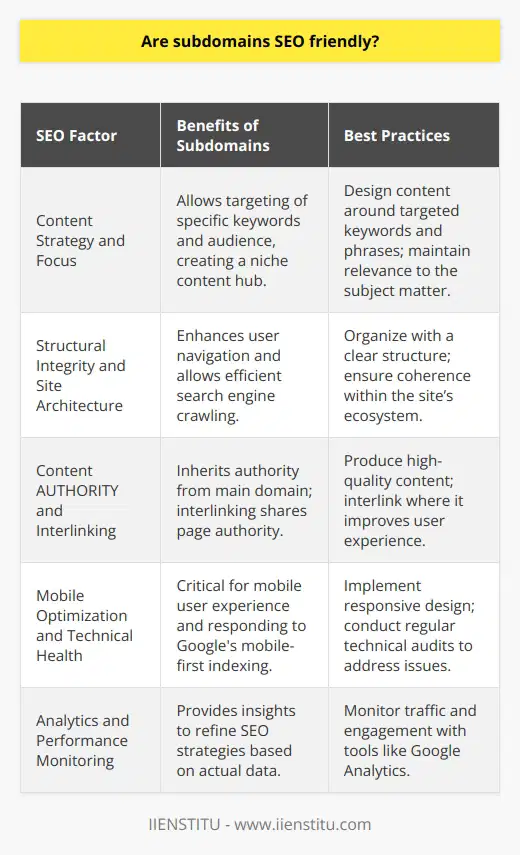
How do I optimize my domain name for SEO?
**Keyword Research and Domain Name Selection**
Optimizing a domain name for SEO starts with thorough keyword research to identify search terms that reflect the blog's content and target audience. Conducting this research can reveal terms that have high search volume and low competition, an ideal combination for gaining a higher search engine ranking.
**Domain Name Length and Readability**
In addition to incorporating relevant keywords into the domain name, it is essential to keep the name short and easily memorable. Short, concise domain names are more likely to be recalled by users and shared with their networks. Moreover, avoid using hyphens or other special characters as these can potentially lead to confusion or domain name registration errors.
**Exact Match Domains Vs. Brandable Domains**
While exact match domains (EMDs) were once popular and considered beneficial for SEO, their effectiveness has diminished due to search engine algorithm updates that penalize low-quality EMDs. Instead, focus on creating a brandable domain name that embodies the blog's thematic elements and personality, as this can lead to higher online recognition and credibility over time.
**Domain Age and SEO**
Although domain age is not a critical factor in SEO performance, older domains have a historical advantage in terms of search engine trust and authority. Therefore, if you are starting a blog and have the option to acquire an older, keyword-relevant domain, this choice may be advantageous for SEO purposes.
**Top-Level Domain Selection**
When selecting a top-level domain (TLD), focus on the most popular and widely recognized options such as .com, .net, or local TLDs. In general, these TLDs are more likely to be trusted by users and search engines alike. Furthermore, choosing a relevant TLD can provide additional information about the blog, such as its target audience or location, and may contribute to better user experience.
**Optimizing Domain Extensions**
Expanding the blog's reach with multiple domain extensions is another strategy to optimize its domain name for SEO. By registering alternative TLDs and redirecting them to the primary domain, one can prevent competitors from registering these variations and potentially benefit from additional traffic. Additionally, this approach can help safeguard the blog's brand identity.
In conclusion, optimizing a domain name for SEO involves careful keyword research, domain name length considerations, focusing on brandable domains, exploring older domain options, selecting a relevant top-level domain, and utilizing appropriate domain extensions. By implementing these strategies, a blogger can enhance their blog's search engine visibility and boost its overall performance.

Do subdomains improve SEO?
Subdomain Usage and SEO Impact
In the realm of search engine optimization (SEO), the use of subdomains is a topic often debated among website owners and digital marketers. While there is no definitive answer, it is worth considering several aspects to determine the potential impact of subdomains on a website's SEO performance.
Understanding Subdomains
A subdomain is a part of a website's architecture that exists independently of the main domain, typically designated for a specific purpose or functionality. For instance, blog.example.com is a subdomain of example.com, harboring a distinct collection of content related to the overarching website.
Content Organization and Relevance
One significant factor to consider is the organizational structure of the website. Subdomains may improve SEO by creating distinct areas for specific topics or content types, effectively streamlining the user experience. This approach can enhance the website's overall relevance by grouping related content in an easily navigable format. Consequently, a well-structured subdomain strategy can result in increased user engagement and lower bounce rates, both vital aspects for SEO gain.
Authority Transfer and Backlinks
However, subdomains are also viewed by search engines as distinct entities, meaning that any link building efforts or authoritative recognition received by the main domain may not directly translate to the subdomain. As a result, subdomain pages may struggle to accumulate the same level of authority and backlink profile as the main domain, which could potentially hinder the subdomain's SEO performance.
Search Engines' Evolving Perspective
It is important to note that search engine algorithms have evolved significantly over the years, becoming more adept at understanding subdomains in context with their main domains. As a result, some experts argue that the potential negative impact of subdomains on SEO has lessened. However, the specific influence of a subdomain on SEO can still vary depending on the search engine in question and the website's broader SEO strategy.
In conclusion, subdomains can improve SEO by facilitating an organized content structure with enhanced relevance and navigability. However, they may also hinder SEO performance due to a lack of authority transfer from the main domain and potential shortcomings in backlink acquisition. Ultimately, whether subdomains prove beneficial to SEO largely depends on the unique needs and goals of the website in question, necessitating a personalized and well-considered approach to their implementation.
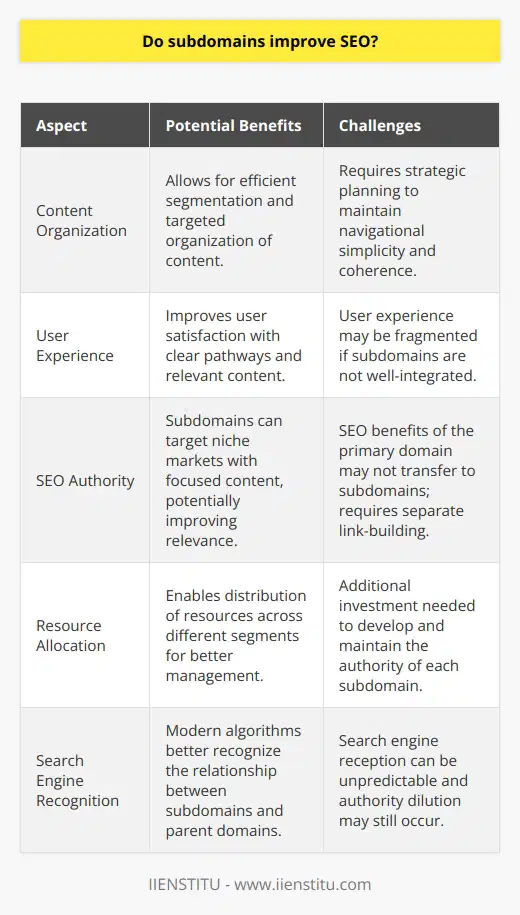
Are subdomains SEO friendly?
Subdomain Structure and SEO
Yes, subdomains are SEO-friendly when implemented correctly. Subdomains function as separate entities in a website's structure, allowing customization tailored to different sections of one's website. This distinct separation of content helps search engines understand and classify the specific topics and goals for each subdomain.
Benefits of Subdomains for SEO
One substantial advantage of utilizing subdomains is the ability to target different keywords and niches within a single website. Subdomains allow for a more organized and focused approach to different segments of content offered on a site, consequently improving visibility and search engine rankings. Additionally, subdomain URLs reflect category keywords, enhancing clarity for users and search engine crawlers alike.
Localized Optimization with Subdomains
For businesses operating internationally or with multiple physical locations, subdomains can significantly aid in local search optimization. By creating location-specific subdomains, search engines can more accurately understand and rank your business in local search results. Moreover, employing targeted subdomains allows businesses to cater their content to particular geographical areas, addressing the unique needs and cultural elements of a specified audience.
Addressing Potential Issues
While subdomains offer various SEO advantages, it's crucial to be cautious of duplicate content. Having identical content across multiple subdomains can negatively impact SEO performance, leading search engines to devalue the content's credibility. Therefore, when implementing subdomains, ensure content is unique and tailored for each section, avoiding redundancy and bolstering search engine rankings.
Conclusion
In sum, subdomains can be a powerful tool for enhancing a website's SEO performance when employed strategically and with attention to localized optimization and content differentiation. By partitioning a website into focused sections, an organization can more effectively target desired keywords and niches, ultimately driving visibility and ranking improvements across search engine results.

What role do domain age and history play in SEO performance?
Domain Age and SEO Performance
Domain age refers to the length of time that a website has been in existence and registered under a particular domain name. History, on the other hand, encompasses the website's previous activities and updates that have been made over time. Both domain age and history significantly impact a website's Search Engine Optimization (SEO) performance, as search engines like Google consider them in determining the credibility and relevance of a website.
Factors of Domain Age
Two substantial factors contribute to domain age's impact on SEO performance – credibility and trustworthiness. Older domains usually have a higher level of credibility and trust since they have had more time to establish a positive reputation. Moreover, older domains have had more time to accumulate valuable backlinks, which directly impact the site's SEO rank. As websites age, they benefit from increased organic traffic, resulting from their long-lasting presence within search engine results.
Importance of Domain History
Domain history can work either advantageously or disadvantageously for a website's SEO performance. If a site has a positive history, comprising of consistent updates and improvements, search engines view it as a well-maintained and relevant source of information. Consequently, the site tends to rank higher within search engine results pages.
However, a poor domain history can have the opposite impact. A history of black hat SEO techniques, spammy backlinks, or multiple ownership transfers may hinder the credibility of the site. Search engines may even penalize such websites, leading to a decrease in their SEO ranking.
Retaining Domain-Age Benefits
To maintain the benefits of an aged domain, website owners need to be consistent with their efforts in optimizing the site for search engines. This includes producing high-quality and relevant content, avoiding any black hat SEO tactics, and regularly updating and improving the website to adhere to changing search engine algorithms. Additionally, keeping track of backlinks and removing any low-quality ones can help maintain a healthy website profile and contribute positively to SEO performance.
In conclusion, domain age and history play crucial roles in a website's SEO performance. Aged domains and a history of positive website updates and improvements serve as indicators of trustworthiness and credibility, enhancing the site's SEO rank. Website owners need to prioritize consistent optimization efforts to preserve and improve their search engine ranking over time.

How does keyword placement in domain names and subdomains impact search rankings?
Keyword Placement in Domain Names and Subdomains
Impact on Search Rankings
The influence of keyword placement in domain names and subdomains on search rankings is an important area to consider when optimizing websites for search engines. Although domains and subdomains containing keywords may initially boost search rankings, the long-term efficacy of this technique remains unclear.
Domain Names with Keywords
Incorporating targeted keywords within a domain name is believed to potentially improve search engine rankings for those specific terms. For instance, if a business is in the coffee industry, owning a domain like 'coffeeshop.com' might provide a slight advantage over a generic domain like 'caffeinestation.com'. However, it is essential to note that while keywords in the domain name might enhance its visibility, the overall impact is minimal compared to other optimization factors such as content quality and backlink profile.
Subdomains with Keywords
As for keyword placement in subdomains, search engines like Google treat them as separate websites in terms of indexing and ranking. Thus, using targeted keywords in subdomains could theoretically lead to improved search visibility for the specific topics these subdomains cover. Nevertheless, search engine algorithms focus heavily on providing the most relevant content to users, so the primary focus should be on producing high-quality content and a strong backlink profile rather than relying solely on keyword-specific subdomains.
Limitations and Considerations
Although domain names and subdomains with targeted keywords might foster positive impacts on search rankings, the efficiency of this technique should not be overstated. Other aspects of search engine optimization, such as high-quality content, website speed, mobile-friendliness, and a comprehensive backlink profile, carry much more weight in search engine algorithms. Consequently, employing keyword-specific domain names and subdomains should be viewed as a supplementary strategy rather than an end-all solution.
In conclusion, keyword placement in domain names and subdomains has some influence on search rankings, but its overall impact is limited compared to other optimization techniques. While incorporating keywords may offer a mild advantage, webmasters should prioritize producing high-quality content and building a robust backlink profile to increase search engine visibility effectively.
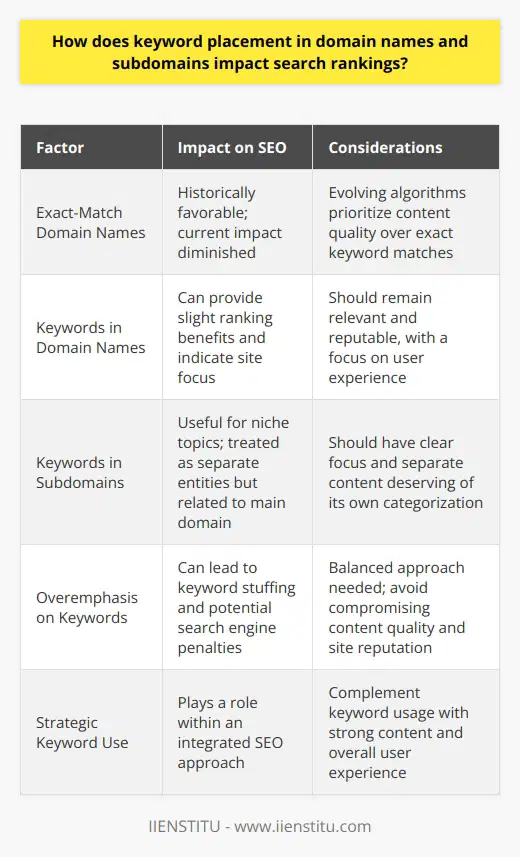
Which SEO techniques are most effective for improving the visibility of subdomains in search engine results pages?
Establishing a Clear Hierarchy
Effective SEO techniques for subdomains are focused on highlighting their relevance and relationship to the main domain to enhance visibility on search engine results pages (SERPs). Establishing a clear hierarchy through the use of relevant naming conventions and proper internal linking is essential to showcase the subdomain's prominence. Each subdomain should be treated as a separate entity with its own set of on-page and off-page SEO practices.
Optimizing On-Page Elements
On-page optimization strategies are crucial for improving visibility on SERPs, with subdomains being no exception. Focusing on key elements such as unique and engaging title tags, meta descriptions, headings, and image alt tags, is necessary to communicate the relevance and quality of the content. Implementing relevant and naturally occurring keywords in the content will also contribute to enhanced visibility.
Leveraging High-Quality Content
Content quality plays a significant role in SEO, as search engines prioritize informative and engaging content. Ensuring that subdomains are updated with well-researched, original, and easily comprehensible content will make them more attractive to users, as well as search engines. This, in turn, will increase the chance of achieving high ranking positions on SERPs.
Building Authority Through Backlinks
Fostering off-page optimization by obtaining backlinks from high-authority domains is another effective strategy for enhancing subdomain visibility. Reach out to relevant industry influencers and websites to amplify content distribution and secure backlinks. Employing targeted outreach tactics and leveraging shareable content, such as infographics and data-driven studies, can boost the chances of attaining high-quality backlinks.
Employing Technical SEO Practices
Attention should also be given to technical SEO practices to ensure smooth and efficient crawling and indexing of subdomains by search engines. Implementing XML sitemaps and adjusting the robots.txt file are necessary measures to guarantee search engines can access the content easily. Additionally, mobile optimization, website speed, and providing a secure user experience are essential for improving visibility on search engine results pages.
In conclusion, multiple SEO techniques, including on-page optimization, producing high-quality content, building authority through backlinks, and employing technical SEO practices, should be employed to improve the visibility of subdomains in search engine results pages. By addressing these critical factors, webmasters can create a user-focused experience that will yield prominent organic search performance for their subdomains.
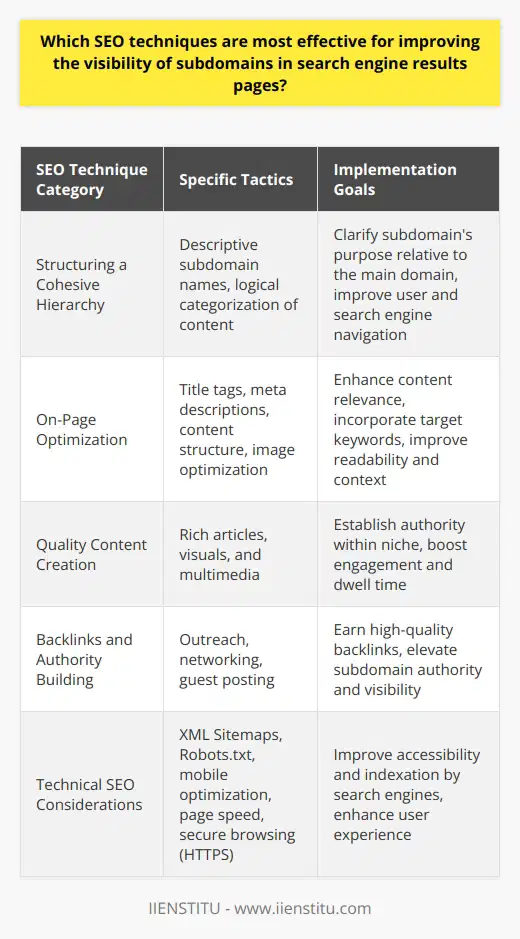
What is the relationship between domain and subdomain in terms of SEO optimization?
Subheading: Defining Domain and Subdomain
In terms of website structure, a domain is the primary address of a website, while a subdomain is a subsection of the main domain. Domains and subdomains are both essential components in SEO optimization, as search engines like Google use them to index and rank websites.
Subheading: The Role of Domains in SEO
Domains play a critical role in SEO because they are indicators of a website's identity and relevance to specific keywords. A well-chosen domain can contribute to higher rankings in search engine results pages (SERPs) and increased visibility for targeted audiences.
Subheading: Importance of Subdomains for SEO
Subdomains, on the other hand, enable website owners to create separate sections within their main domain catering to different content topics or target markets. They can also contribute to improved SEO by allowing for better organization and targeting of specific niches, thus resulting in higher chances of ranking in SERPs for relevant queries.
Subheading: Connection between Domain and Subdomain in SEO
The relationship between domains and subdomains in SEO optimization is inherently connected, as both elements can have a significant impact on a website's overall search engine performance and visibility. While domains provide the foundation for website identity and relevance, subdomains act as supportive elements that enhance niche targeting and content organization for better SEO prospects.
Subheading: Pros and Cons of Utilizing Subdomains
Despite the benefits, utilizing subdomains can have drawbacks, such as potential content duplication or the spreading of domain authority across multiple subdomains. This can negatively impact a website's overall SEO value. Therefore, it is crucial for website owners to weigh the pros and cons of incorporating subdomains into their SEO strategy and carefully plan the organization of their website content to optimize search engine performance.
In conclusion, the relationship between domain and subdomain in terms of SEO optimization is complex and interconnected, with both elements playing significant roles in a website's search engine ranking and visibility. Proper utilization of domains and subdomains, coupled with a well-planned content organization strategy, can significantly enhance a website's SEO performance and ensure a higher likelihood of success in the competitive online landscape.
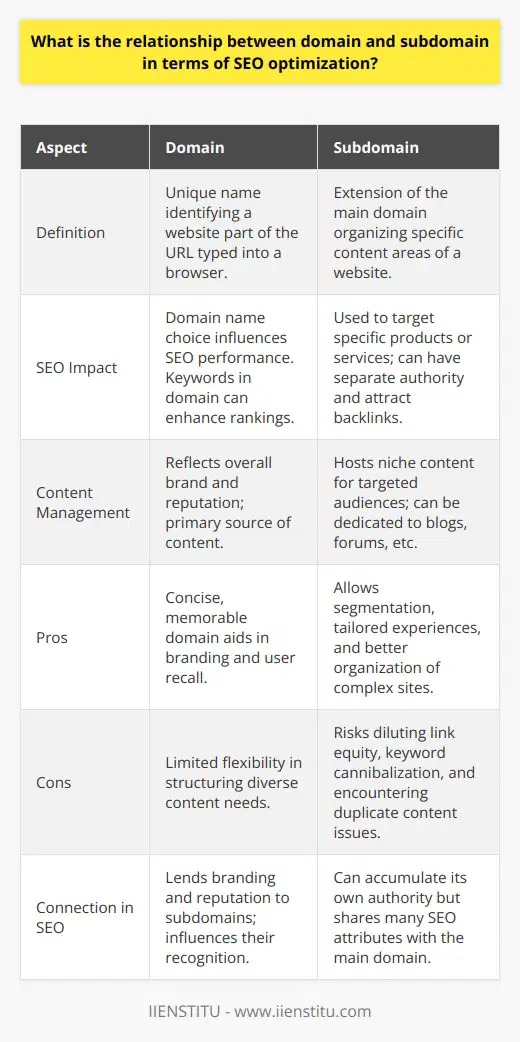
How can one decide whether to use a subdomain or a subdirectory for optimizing SEO performance?
Subdomain vs Subdirectory Considerations
To determine whether to use a subdomain or subdirectory for optimizing SEO performance of a blog post, essential factors must be evaluated. These factors encompass the website's structure, user experience, and targeted audience.
Website Structure and Existing SEO
Firstly, consider the current website structure and existing SEO performance. If the blog content is closely related to the main website's theme, a subdirectory is recommended, as search engines perceive it as part of the primary domain. This relationship allows the blog to contribute to the website's overall SEO value, increasing the chances of higher rankings.
User Experience and Navigation
Secondly, examine the user experience and navigation aspects. A seamless user experience is crucial not only for capturing visitors' attention but also for establishing a positive association with search engines. If the blog integrates with and complements the main website, a subdirectory would be appropriate, as it ensures a cohesive browsing experience. Conversely, if the blog diverges significantly from the core website, a subdomain can create a distinct and separate user experience without detracting from the main site's focus.
Target Audience and Content Relevance
Lastly, scrutinize the target audience and content relevance. A subdomain might be the better choice if the blog targets a different audience or explores off-topic subjects that stray from the primary site's theme or focus. By creating separate entities, the website can produce independent SEO value, which may eventually contribute to the overarching domain authority.
Conclusion
In conclusion, choosing between a subdomain or a subdirectory for optimizing SEO performance ultimately depends on the website structure, user experience, and targeted audience. Analyzing these factors helps to ensure that the chosen strategy aligns with the website's overall objectives, delivering a consistent and well-structured user experience to improve SEO rankings.
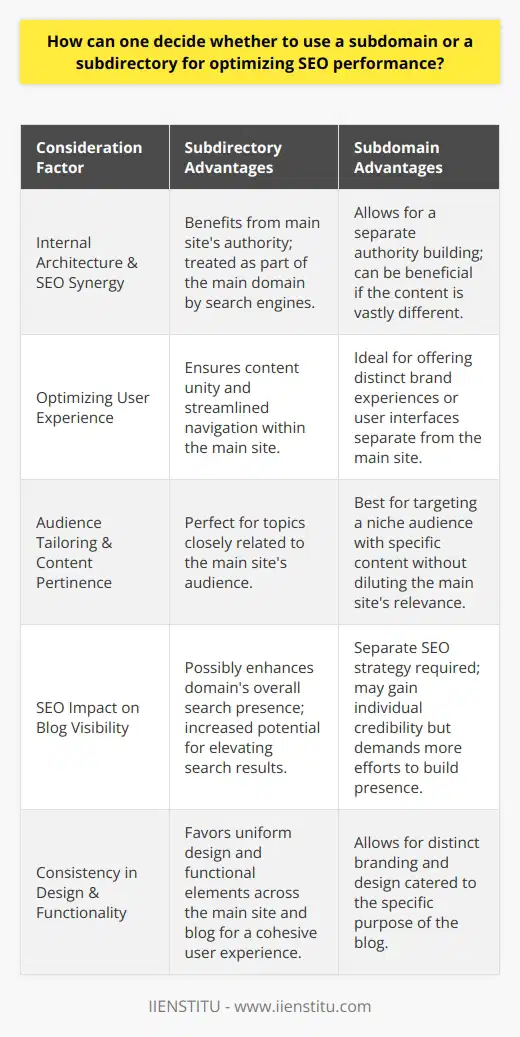
To what extent do ccTLDs (country-code top-level domains) impact local SEO and search rankings in comparison to gTLDs (generic top-level domains)?
Impact of ccTLDs on Local SEO
Country-code top-level domains (ccTLDs) are internet domain extensions assigned to specific countries or territories. Examples include .uk for the United Kingdom, .au for Australia, and .de for Germany. They play a significant role in local search engine optimization (SEO) and search rankings, primarily because search engines associate them with region-specific content.
Search Engine Perceptions
Search engines, such as Google, view ccTLDs as clear indications of the target audience's location. Consequently, websites with appropriate ccTLDs are more likely to rank higher in local search results within the respective country. Conversely, generic top-level domains (gTLDs) like .com, .org, and .net are perceived as independent of specific locations and target broader, global audiences.
Geo-targeting Benefits
Websites using ccTLDs can capitalize on geo-targeting benefits, boosting their visibility within local search results and attracting more relevant, region-specific traffic. This increased exposure can translate to potential customers, making ccTLDs essential for businesses seeking comprehensive local SEO strategies.
Limited Global Appeal
Despite the advantages of ccTLDs in local SEO, they may not fare as well in global search rankings when compared to gTLDs. Due to the perception of region specificity, websites with ccTLDs can struggle to generate traffic from users outside the targeted country, impacting their overall search ranking and visibility.
User Trust Factor
Users are generally more trusting of ccTLDs when seeking information tailored to their location, as the domain extensions convey a certain level of authority and expertise relating to a specific country. This trust can directly contribute to a website's conversion rate, making strong ccTLD choices critical for improving local SEO performance.
Comparing ccTLDs and gTLDs
In comparing the impact of ccTLDs and gTLDs on local SEO and search rankings, ccTLDs are considered more effective in targeting regional audiences. While gTLDs cater to a global market and enjoy broader visibility, they don't provide the same level of local relevance as their country-specific counterparts. Thus, ccTLDs remain essential for businesses aiming to enhance their regional digital presence.
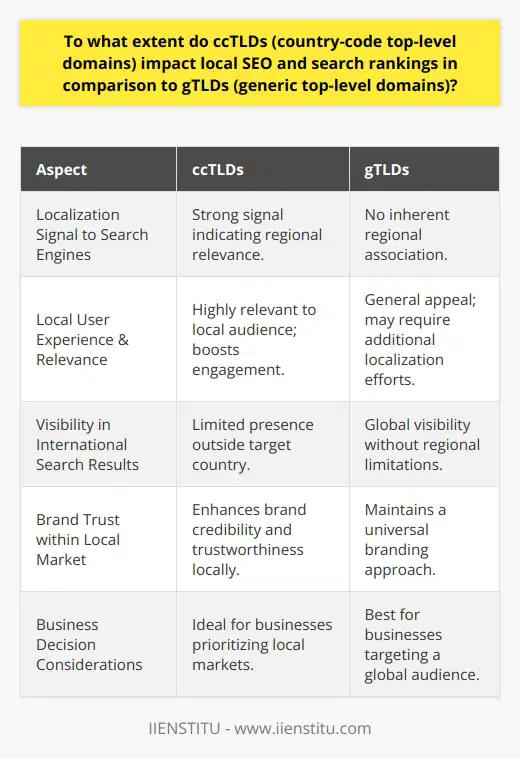
How do I optimize my domain name for SEO?
**Choosing a Domain Name**
In order to optimize your domain name for SEO (Search Engine Optimization), one must first focus on selecting a domain name that represents the blog's content or business accurately. Choosing a clear and descriptive domain name not only enables potential readers to identify the blog's subject matter quickly, but also increases the likelihood of being ranked higher in search engine results. Moreover, a domain name should ideally be concise, memorable, and easy to pronounce, which facilitates sharing and increases direct traffic.
**Using Keywords Strategically**
Another essential factor in optimizing domain names for SEO is the strategic use of keywords. Including relevant keywords in the domain name that are commonly searched by the target audience can significantly boost search engine rankings. However, it is important to avoid over-optimizing or employing keyword stuffing techniques, as search engines may consider this a manipulative practice and penalize the website accordingly. Instead, focus on incorporating one or two targeted keywords that flow naturally within the domain name.
**Emphasizing Branding**
In addition to optimizing keywords, emphasizing branding in a domain name is an effective way to improve SEO. Unique and distinguishable brand names within a domain inspire trust and credibility among users, which in turn, may lead to higher click-through rates and social media shares. While choosing a brand-oriented domain name, consider how users may engage with the name, and refrain from using excessively generic or ambiguous terms.
**Selecting the Right Top-Level Domain (TLD)**
Though primary focus lies on the second-level domain (SLD), the right top-level domain (TLD) can also contribute to SEO optimization. While the most popular and widely-recognized TLD is '.com', other TLDs, such as '.org', '.net', or localized TLDs like '.co.uk', can also be suitable depending on the blog's target audience and purpose. It is important to research and choose a TLD that aligns with the blog's objectives and target market to maximize SEO benefits.
**Avoiding Hyphens and Numbers**
To further optimize a domain name for SEO, it is advisable to avoid using hyphens and numbers. These tend to complicate domain names and make them difficult to remember, thus inhibiting shareability. Additionally, hyphenated domain names may be perceived as less credible by users, leading to lower click-through rates.
In conclusion, optimizing a domain name for SEO involves a combination of selecting a clear, descriptive, and brand-focused name, utilizing targeted keywords, choosing an appropriate TLD, and avoiding the use of hyphens and numbers. By implementing these strategies, creators can significantly improve their blog's visibility, credibility, and search engine ranking.

Do subdomains improve SEO?
Subdomain Impact on SEO
Subdomains can positively impact search engine optimization (SEO) when appropriately used in a blog post. By implementing strategically adjusted subdomains for different topics or languages, website owners can facilitate improved organization of content, which can contribute to a better overall user experience.
Enhanced User Experience
Readers expect a certain level of coherence and ease when browsing content online. Subdomains linked to the main website allow for the presentation of related content in a structured way. Organizing information according to specific themes or languages encourages users to explore further, potentially increasing dwell time and decreasing bounce rates. These factors contribute to the improvement of a website's search engine rankings.
Domain Authority and Link Equity
Subdomains help preserve domain authority, an important ranking factor that takes into account the trustworthiness, relevance, and quality of a website in the eyes of search engines. Each subdomain inherits the main domain's authority, which supports content discoverability. Link equity is also facilitated by subdomains, as external links directing to any part of a website collectively contribute to its authority. Consolidated link equity boosts the overall website's search engine presence.
Effective Keyword Targeting
As each subdomain has its unique content, website owners can target specific keywords relevant to the content on each one. This focused approach can lead to higher rankings for those keywords, increasing the visibility of the content to its intended audience. This, in turn, may lead to higher website traffic and improved search engine rankings.
Localization and Internationalization
Subdomains also support localization and internationalization strategies. By creating subdomains for content in different languages, website owners can cater to a wider, global audience more easily. This can improve visibility in foreign search markets, potentially increasing traffic and enhancing overall SEO performance.
In conclusion, while subdomains offer potential benefits for SEO, their efficacy depends on appropriate strategic implementation. Leveraging subdomains in organizing content according to specific topics, languages, or market segments can improve user experience, domain authority, keyword targeting, and international reach. Subdomains should be employed carefully, considering factors such as the nature of the content, the targeted audience, and the objectives of the website.

What is the relationship between domain and subdomain in terms of SEO optimization?
Subheadings: Domain Authority, Subdomain Relationship, SEO Optimization
Domain Authority
The relationship between domain and subdomain in terms of Search Engine Optimization (SEO) optimization is complex. It primarily revolves around domain authority, which is a website's ability to rank in search engine results pages (SERPs). A high domain authority is essential for garnering organic traffic, which is a crucial factor in determining the overall success of a website.
Subdomain Relationship
A subdomain is part of the main domain but functions independently from it. Using a subdomain is a common approach to targeting different niches or markets within a single domain. Subdomains inherit domain authority from the main domain, but they are considered separate entities by search engines.
SEO Optimization
For effective SEO optimization, both the main domain and its subdomains must follow SEO best practices, which include optimizing metadata, creating high-quality content, and obtaining backlinks from authoritative sources. The relationship between the two should be coherent and well-structured to clarify the hierarchy of information.
Thus, in terms of SEO optimization, the relationship between domain and subdomain is one of interdependence. An optimized domain may positively impact associated subdomains, but subdomains must also adhere to SEO guidelines independently to achieve desired SERP rankings. Ultimately, the harmony between domain and subdomain is vital for an effective online presence.

What are the best practices for naming subdomains in order to effectively enhance search engine optimization?
Best Practices for Subdomain Naming
Keyword Research
Effective search engine optimization (SEO) begins with thorough keyword research. Identifying relevant, high-performing keywords provides a foundation for subdomain naming, ensuring that search engine users can easily find the desired information.
Utilize Targeted Keywords
Incorporate these targeted keywords into subdomain names to increase visibility. Search engines prioritize domains and subdomains that directly reflect users' search queries. Including relevant keywords in the subdomain increases the likelihood of higher search engine rankings.
Maintain Clarity and Simplicity
Subdomain names should be concise, clear, and simple. Avoid unnecessary wordiness or complicated expressions, which may confuse or deter potential website visitors. Instead, prioritize creating subdomains that are easily understandable and directly reflect the site's content.
Hyphen Usage and Separation of Words
Although the use of hyphens in subdomains is acceptable, exercise caution when choosing this option. Overusing hyphens may impede readability and deter potential site visitors. If necessary, opt for separating words through clear, natural breaks within the subdomain.
Region-Specific Subdomains
For businesses targeting specific geographic locations, consider utilizing region-specific subdomains. Using regional keywords and language in subdomains can boost search engine optimization for targeted locales, increasing organic traffic from users in that particular area.
Domain Authority Enhancement
Building and maintaining domain authority is crucial for achieving high search engine rankings. Creating a structure with subdomains effectively distributes traffic and link equity throughout the site, boosting overall domain authority and improving SEO efforts.
Mobile-First Design Approach
As the majority of online browsing now occurs via mobile devices, search engines prioritize mobile-friendly content. Design subdomains with a mobile-first approach, maximizing ease of use and readability for all users on various devices.
Continuous Monitoring and Analysis
Lastly, consistent monitoring and analysis of subdomain performance are essential for successful SEO practices. Assessing and adjusting subdomain naming, structure, and content accordingly will ensure that the website remains optimized for search engine success.

Is it beneficial for SEO purposes to operate multiple domains, and if so, under which circumstances?
Advantages of Multiple Domains
Operating multiple domains can indeed be beneficial for SEO purposes under certain circumstances. The key factor influencing the utilization of multiple domains lies in the domains' relevance to the content being showcased. For instance, if a business has multiple product lines, each with distinct audiences, it may be advantageous to establish separate domains.
Targeted Keyword Strategy
By having dedicated domains, businesses can employ a targeted keyword strategy that allows them to focus on a specific niche. This will likely lead to better search engine rankings for those keywords, and thus better user experience. A focused content strategy for each domain can also increase the likelihood of attracting and retaining site visitors with relevant interests.
Domain Age and Authority
Launching multiple domains can also be helpful in building domain authority – an essential component of SEO success. As new domains age, they have the potential to gain authority, provided they feature high-quality content and receive backlinks from reputable sources. Consequently, having multiple authoritative domains can lead to improved SEO outcomes in the long run.
Geographic and Language Specificity
If a business operates on an international scale, having multiple domains tailored to different regions or languages can also bolster SEO performance. By hosting separate domains with relevant top-level domain extensions and language-specific content, search engines will likely recognize these domains as more relevant and authoritative to their respective audiences, which will bolster their visibility online.
Avoiding Duplicate Content Penalties
However, it is essential to mention that utilizing multiple domains should not be done merely for the sake of expanding one's online footprint. Each domain should have distinct, valuable content and avoid duplicate content, as this could incur search engine penalties and harm SEO efforts.
Conclusion
In conclusion, operating multiple domains can be advantageous for SEO purposes, but only under specific circumstances. When done strategically, with distinct and relevant content, multiple domains can help businesses target niche audiences, build domain authority, and cater to international markets. As with any SEO strategy, it is vital to adhere to best practices and continuously produce high-quality content to optimize search engine performance.
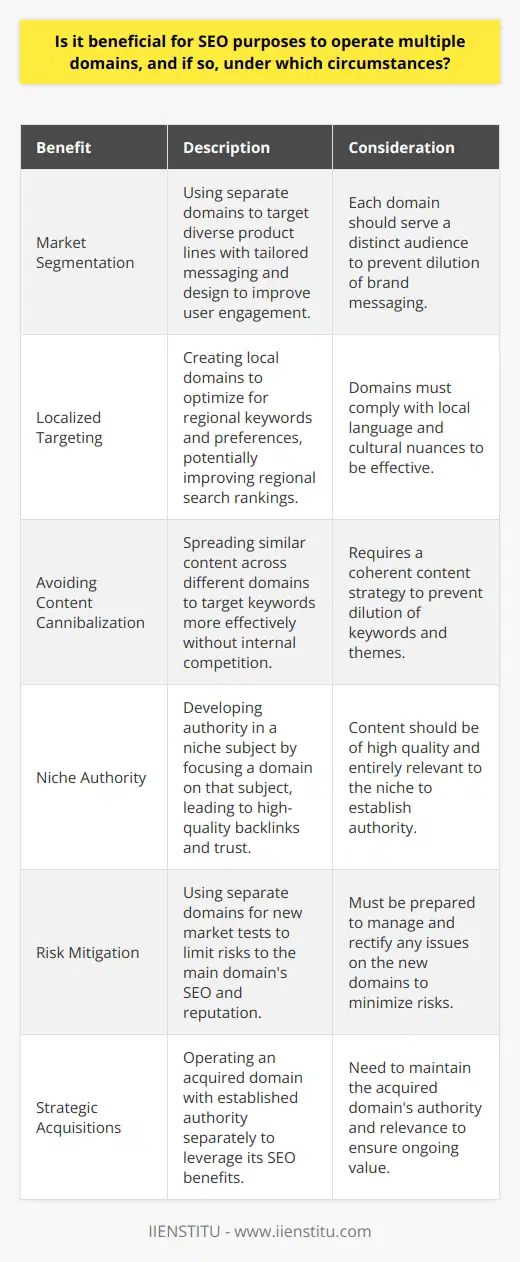
How does the choice of a domain name, specifically in regards to keywords and relevance, contribute to the overall SEO performance of a website?
Domain Names and SEO Performance
Importance of Keywords in Domain Names
Incorporating relevant keywords in the domain name of a blog post can significantly improve a website's Search Engine Optimization (SEO) performance. Keywords act as indicators of the content and purpose of a blog post, making it more discoverable to users through search engine platforms such as Google, Bing, or Yahoo.
Semantic Relevance and SEO
The use of semantically relevant words within the domain name not only contributes to enhancing the website's visibility in search engine results, but also improves the user experience. A domain name that accurately reflects the content of a blog post enables users to quickly identify the topic, increasing the likelihood of them clicking through to the website. Consequently, this results in higher organic traffic, better click-through rates, and a reduction in bounce rates.
Keyword-based Domain Names vs Brand-based Domain Names
When selecting a domain name, blog owners should consider balancing keyword-based domain names with brand-based domain names. While having a keyword-rich domain can result in immediate SEO benefits, creating a unique, memorable, and identifiable brand through the domain name may lead to long-term customer loyalty and overall better website performance.
Example
For example, a travel blog featuring content relating to budget travel could incorporate keywords such as ‘budget’ and ‘travel’ in their domain name (e.g., budgettravelblog.com). However, they could also create a brand-based domain name that is distinctive and memorable (e.g., thriftywanderlust.com). The latter not only reflects the core purpose of the website, but also helps to build a unique brand in the highly competitive travel blogging sphere.
In conclusion, the choice of a domain name is crucial for the overall SEO performance of a website. Integrating targeted keywords and ensuring semantic relevance can contribute greatly to increased visibility, user engagement, and better content indexing. Additionally, blog owners should consider balancing keyword inclusion with the creation of a distinct and memorable brand to maximize their competitive advantage in the online space.
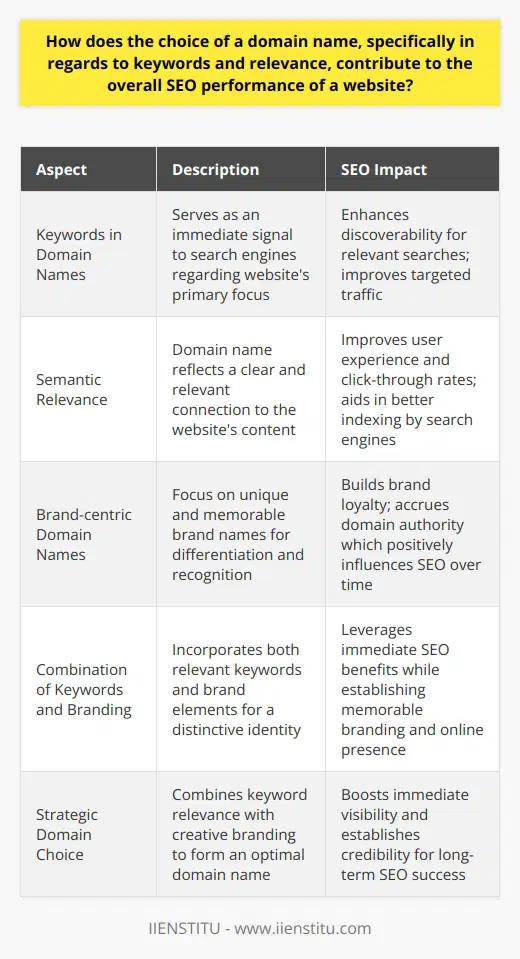
Are subdomains SEO friendly, and how should one approach optimizing them for search engine rankings?
Subdomain SEO Friendliness
Subdomains are indeed SEO friendly. They function as independent entities within the parent domain, possessing their own set of SEO metrics. Consequently, search engines like Google differentiate between the parent domain and its subdomains, affecting their ranking differently.
Approach to Subdomain Optimization
When optimizing subdomains, applying affordable SEO strategies is essential. Initially, one should choose a subdomain name that relates closely to the targeted keywords. This approach makes it easier for search engines to associate the subdomain with its relevant content, aiding in the optimization process.
Individual SEO Efforts
It's crucial to understand that subdomains require individual SEO efforts. Search engines treat them as separate websites. Therefore, they need individual attention concerning keyword usage, meta descriptions, and backlink strategy.
Importance of Backlinks
A strategic approach to backlinks plays a crucial role in subdomain optimization. Earning high-quality backlinks from authoritative websites will boost subdomain ranking. Simultaneously, the avoidance of low-quality backlinks will prevent penalties from search engine algorithms.
Internal Linking Strategy
Additionally, employing an effective internal linking strategy can help in optimizing subdomains. It aids in site navigation, distributing page authority, and enhancing user experience. A well-structured internal link network effectively communicates the relationship of subdomains to search engines, improving SEO performance.
Quality Content
Above all, consistent production of high-quality, relevant content is essential. It forms the backbone of any successful SEO strategy. Updating content regularly with the insertion of relevant keywords maintains and improves search engine ranking while attracting and retaining traffic.
In conclusion, optimizing subdomains for SEO entails a comprehensive understanding of their unique characteristics. It requires ongoing efforts in keyword usage, backlink strategy, internal linking, and quality content. If effectively executed, the optimization of subdomains can significantly enhance overall domain performance.
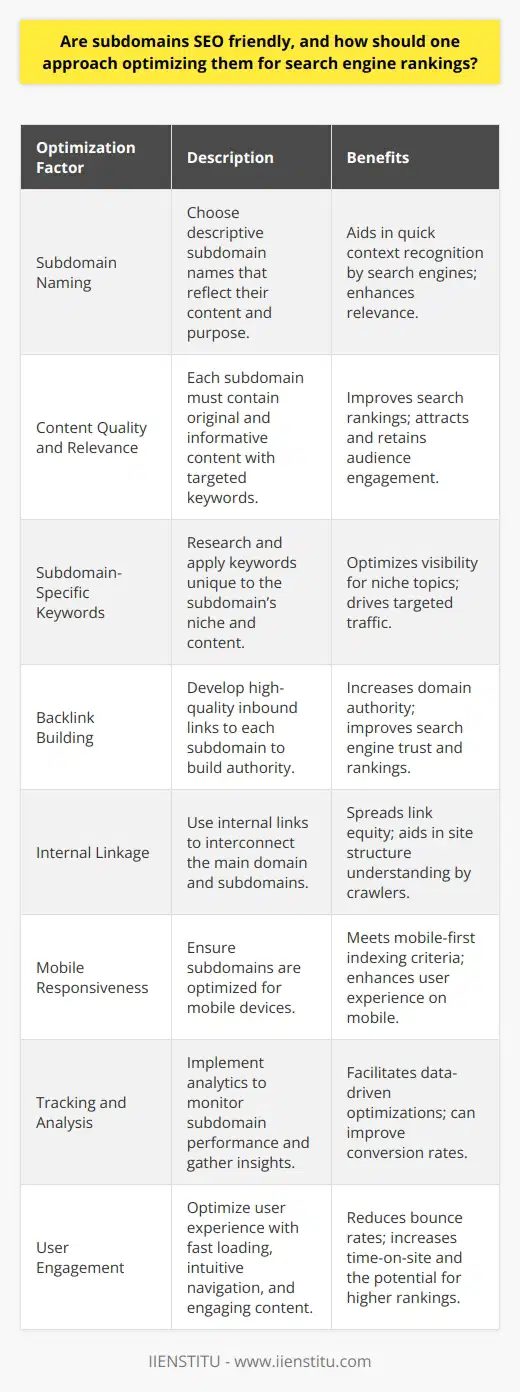
What is the optimal domain length to maximize SEO performance, and how does this aspect affect search engine rankings?
Understanding Optimal Domain Length
The domain length of a blog post can significantly impact the SEO (Search Engine Optimization) performance. A short 5 to 15-character domain name is optimal in maximizing SEO performance.
Influence on the Search Engine Rankings
Search engine rankings depend on various factors, two of which are simplicity and recall value of domain names. Short domain names are easy to remember and simple to type into a browser URL bar. These qualities potentially raise a webpage’s number of direct visits, favourably affecting the website’s ranking on search engines, such as Google.
Role of Short URLs in SEO
Short URLs often provide greater visibility and recognition. Hence, they generally lead to a higher click-through rate (CTR). Besides, search engines prefer short, crisp URLs over long, complex ones. As the search engine's algorithm attributes a high value to user-friendliness, short URLs significantly enhance SEO performance.
Impact of Long URLs
Long URLs, on the contrary, often confuse the search engine algorithms, negatively impacting the SEO performance. The user experience can also be compromised due to potential errors during manual entry of long URLs. This can cause a drop in direct visits, thus reducing the search engine ranking of the website.
Final Thoughts
Therefore, the length of a domain has a profound impact on SEO performance and accordingly, on the search engine rankings. Short domain lengths, falling within the range of 5 to 15 characters are considered optimal for maximum SEO performance.
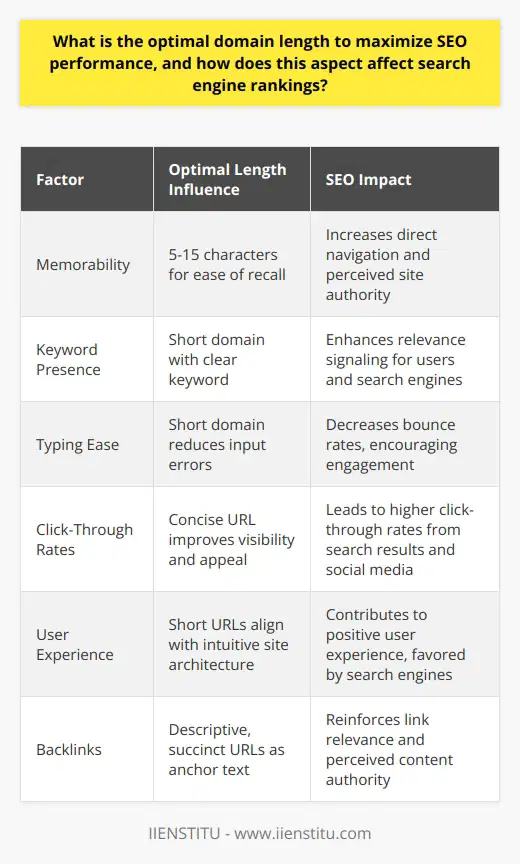
In reference to SEO, is it advantageous to have multiple domains or should one focus on optimizing a single domain for the best results?
Optimal Utilization of Domains in SEO
For SEO, concentrating on a single domain typically yields the best results. Allocating resources to create and optimize content on one site tends to increase domain authority, which in turn improves search rankings. Handling numerous domains can divide those resources, possibly resulting in lesser quality content spread across several sites.
Efficiency and Authority
When you maintain multiple domains, you spread thin your SEO efforts. Focusing on a single domain allows aggregate your SEO efforts, enhancing efficiency. Concentrating high-quality content on a single site over time typically enhances your domain authority. Search engines recognize this authority and reward it with better rankings.
Domain Splitting: A Caution
Nevertheless, there exist scenarios where multiple domains might be beneficial for businesses with diversified services or multiple brands. Yet, SEO might face a significant challenge: potential duplicate content. Search engines may struggle to determine which domain to rank highest when they spot repetitive content.
The Impact of Duplicate Content
Search engines usually prioritize a single domain, leading to diminished visibility for your other domains. Content consideration is, therefore, crucial when managing multiple domains. It's advisable to create unique, quality content for each website to prevent this issue.
Single vs Multiple Domains: A Conclusion
In conclusion, for SEO, focusing on a single domain generally provides the optimum results. This strategy facilitates resource concentration, boosts domain authority, and promises enhanced visibility. Employing multiple domains demands careful planning and unique content creation to evade the pitfalls of duplicate content.
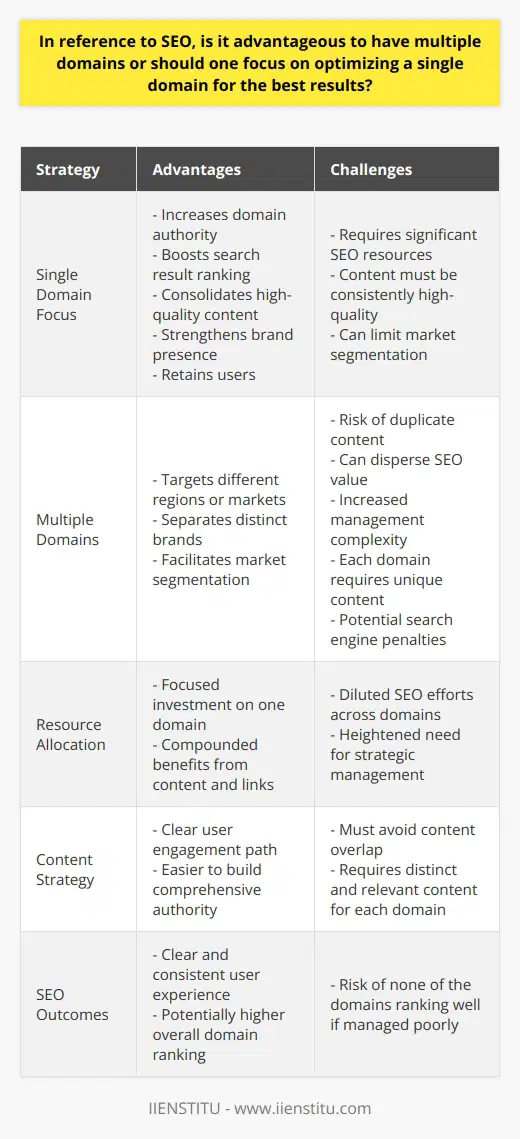
Do subdomains improve SEO, and if so, what factors should be considered when implementing them for search engine optimization?
Impact of Subdomains on SEO
Subdomains can provide SEO benefits when utilized correctly. They serve as keywords impacting a website's traffic, thus enhancing its SEO performance.
SEO Benefits of Subdomains
Firstly, search engines recognize subdomains as separate websites, boosting the probability of ranking multiple websites for targeted keywords. Subdomains highlight specific keywords relevant to your primary domain, making it more attractive to search engines.
Strategic Positioning of Subdomains
Irrespective of the industry, strategic positioning of subdomains becomes crucial. If your website covers different content areas or offers different services, then creating a subdomain for each area improves specific content visibility for search engines.
Structuring Relevant Content
Relevance matters in SEO. Putting content in appropriate subdomains improves its relevance to specific queries, leading to an increase in traffic from search engine results. Thus, structuring your website with sensible content under each subdomain enhances user experience and boosts search engine rankings.
Consideration of Geotargeting
If your business operates in different geographic locations, using subdomains targeted at these locations can improve SEO. This geographical targeting enhances visibility in local search results, thus augmenting your overall SEO performance.
Link Building Strategy
Link building, an essential SEO technique, can be optimized by utilizing subdomains. The creation of subdomains means more websites linking back to your main domain, reinforcing your online presence and improving your SEO ranking.
In summary, implementing subdomains optimizes SEO promotion when used strategically. However, it requires thorough analyses of your content, keyword strategies, positioning strategies, and geotargeting considerations to fully exploit its potential. As always, the user experience remains crucial in planning and executing these strategies, so avoid the temptation to overcomplicate your site structure.

Are subdomains SEO friendly, and what strategies can be employed to optimize subdomains without negatively affecting the main domain's standing in search results?
Subdomain SEO Friendliness
Subdomains are indeed SEO friendly. Major search engines like Google consider subdomains as separate entities from the main domain. Therefore, they can accrue their own search authority and help create a broader digital footprint, all while remaining under the control of the main domain.
Optimizing Subdomains
Different strategies can optimize subdomains. One is by ensuring relevant and high-quality content. Including target keywords in the content can help improve ranking. Moreover, adopting a consistent linking strategy boosts the SEO performance of both main domain and subdomains. For instance, interlinking subdomains and the main domain can spread domain authority and improve overall site structure.
Subdomain Consistency
Maintaining uniformity across the main domain and subdomains is crucial. This includes consistency in branding, design, and user experience. A disparate appearance could confuse visitors and search engines, causing a potential dip in rankings.
Avoiding Negative Impact on Main Domain
To prevent negative impacts on the main domain's search ranking, carefully managing outbound links on subdomains is recommended. Excessive outbound links can drain the domain's authority. Moreover, refraining from duplicate content across the main domain and subdomains is vital to avoid potential SEO penalties.
Utilizing Google Search Console
To monitor subdomain performance, using tools like Google Search Console is advisable. This can provide insights on how to tweak the subdomain's SEO strategies to improve its standing in the search results without negatively affecting the main domain's status.
In conclusion, subdomains can be SEO friendly and can be effectively optimized through different strategies without affecting the main domain's search results standing.
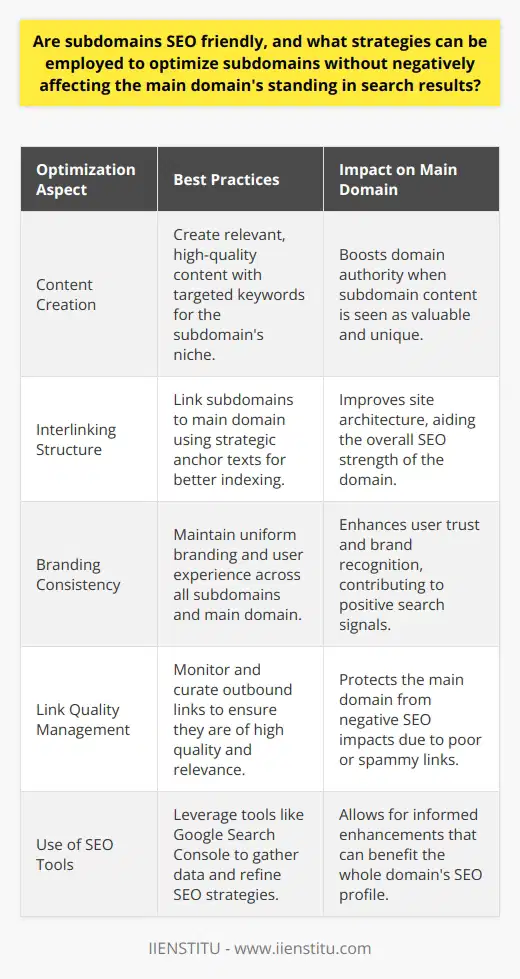
Is it good for SEO to have multiple domains, and under which circumstances may such an approach be beneficial or detrimental to a website's overall search engine performance?
Advantages of Multiple Domains for SEO
Having multiple domains can be beneficial for SEO if utilized in the right way. One significant advantage is keyword-rich URLs. When the domain name contains high-value keywords, it can boost organic search rankings. Moreover, it can allow businesses to digitally diversify their portfolios across different websites. This strategy can offer protection during a ranking algorithm update, which may negatively impact some sites while leaving others unaffected.
Potential Drawbacks
Nonetheless, having multiple domains can have individual drawbacks, too. The high costs associated with multiple domain purchases and maintenance could strain business resources. Plus, the practice of splitting website traffic among multiple domains might weaken the overall SEO strength of one primary domain. Hence, it's crucial to balance the advantages and potential downsides of owning multiple domains.
Focused Approach versus Multiple Domains
In some situations, maintaining a single, authoritative website can perform better in search engine rankings. A coherent, focused, and well-structured website often attracts high-quality backlinks, all contributing positively to the overall SEO. If the strategy is to dominate one targeted niche, a single, strong domain would be more advantageous than multiple domains.
The Redirect Strategy
In contrast, businesses with broader offerings can use multiple domains to strengthen their SEO performance. The strategy here is to redirect all domains to one primary domain, thereby channeling potential visitors to one place. This approach can enhance visibility, consolidate website traffic and create a more substantial online presence. Mandatory in this strategy is the proper implementation of redirects to avoid any SEO dilution or penalties.
In conclusion, whether to have multiple domains largely depends on the nature of the business and its offerings, along with a careful consideration of the resources available for efficient website maintenance and application of the most efficient SEO strategy.

Do domain names matter for SEO, and if so, how do factors such as length, keyword placement, and top-level domain extension contribute to a website's search engine visibility?
Domain Relevance in SEO
Yes, domain names serve a crucial role in Search Engine Optimization (SEO). An effective, appropriately designated domain name boosts visibility in search engines. Domain names carry significant weight in algorithmic assessments of a website's relevance to specific inquiries.
Keyword Placement
Primarily, keyword placement in domain names influences a website's search engine rankings. Search engines often perceive domains containing primary keywords as more relevant to searches involving those keywords. Thus, using keywords in domains conspicuously enhances search engine rankings.
Length of Domain Names
The length of domain names also impacts SEO. Short, concise domain names are easily memorable for users and drive more direct traffic. Moreover, search engines prefer short domain names due to their likelihood of relevance to a search keyword.
Top-Level Domain Extension
Top-level domain extensions (TLDs) contribute significantly to a website's search engine visibility. Search engines favor sites with specific TLDs like .edu, .gov, and .org due to the credibility associated with these domain extensions. TLDs like .com are also reliable as they are widespread and recognized by users and search engines alike.
Therefore, domain names bear substantial importance in SEO. The placement of primary keywords within domain names, the length of the domain, and the TLD used all impact a website’s visibility on search engines. Optimizing these factors can significantly improve a website's SEO performance.
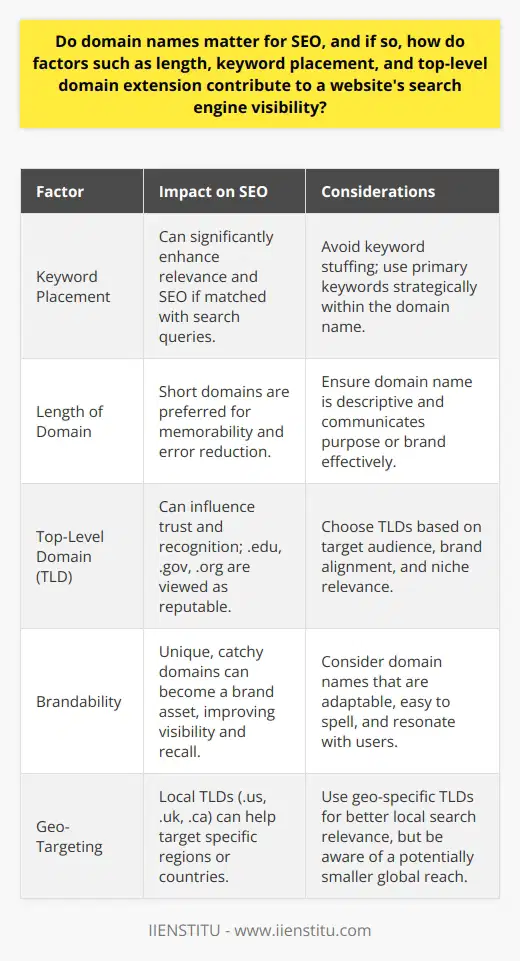
What is the best domain length for SEO, and how does this aspect influence factors such as user experience and search engine rankings?
Ideal Domain Length for SEO
The optimal domain length for search engine optimization (SEO) is between six to fourteen characters. This ideal length includes the domain name only and excludes the 'www' prefix and '.com' suffix.
Domain Length: A Determining Factor
The domain length impacts the SEO remarkably. Lengthy domains could confuse and deter users. They are challenging to remember, increasing the risk users will make mistakes when typing. Therefore, shorter domains enhance the user experience by being more memorable and user-friendly.
Impact on Search Engine Rankings
Moreover, search engines such as Google favor shorter, succinct domains. They can easily crawl and index shorter domains. Thus, the length of the domain directly affects the website's search engine ranking. Shorter domains have higher chances of achieving better search rankings due to greater visibility, usability, and recall value.
User Experience and SEO
The connection between the user experience and SEO is undeniable. A user-friendly domain is more likely to generate traffic, reducing bounce rates, and increasing dwell time on the site. High traffic and user engagement significantly influence the search ranking of the website.
In conclusion, while choosing a domain name, one should focus on keeping it short and relevant. This strategy ensures optimum SEO results, thereby enhancing user experience and boosting search engine rankings.
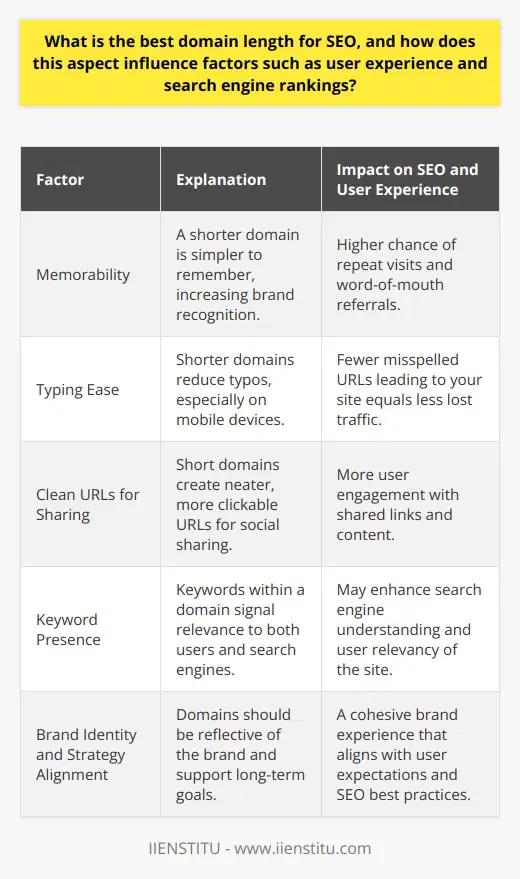
To what extent do multiple domains or subdomains improve SEO, and what are the potential risks or benefits associated with such strategies for optimizing search engine performance?
Domains and SEO
Multiple domains or subdomains can enhance SEO when properly implemented. They provide additional opportunities for targeting particular keywords or themes, potentially improving search visibility and driving more traffic. Subdomains can also help to organize a website and create a clear hierarchy of information.
Potential Risks
However, the main risk associated with this strategy is that it may split the SEO authority between the main website and its subdomains. For instance, Google might view a main site and its subdomain as separate entities, which may dilute the authority and link equity of the main website. Without a proper strategy for linking and uniformity, multiple domains can hinder overall SEO performance.
Beneficial Aspects
On the other hand, multiple domains or subdomains can offer several benefits. They provide a way to target a specific market or audience, giving a business an edge over competitors. This is particularly useful for businesses that operate in diverse markets or offer a wide range of products or services. Multiple domains also allow for more precise tracking in SEO and web analytics.
Conclusion
While there is no definitive answer to the extent to which multiple domains or subdomains can improve SEO, it is clear that proper execution is crucial. They can offer significant benefits but also present potential risks. Therefore, businesses must weigh up these factors and formulate a strategic approach to optimizing their search engine performance.
